
About UsThe Numismatic Bibliomania Society is a non-profit organization devoted to the study and enjoyment of numismatic literature. For more information please see our web site at coinbooks.org SubscriptionsThose wishing to become new E-Sylum subscribers (or wishing to Unsubscribe) can go to the following web page link MembershipThere is a membership application available on the web site Membership Application To join, print the application and return it with your check to the address printed on the application. Membership is only $20 to addresses in the U.S., $25 for First Class mail, and $30 elsewhere. For those without web access, write to: David M. Sundman, Treasurer
AsylumFor Asylum mailing address changes and other membership questions, contact David at this email address: dsundman@LittletonCoin.com SubmissionsTo submit items for publication in The E-Sylum, just Reply to this message, or write to the Editor at this address: whomren@gmail.com BUY THE BOOK BEFORE THE COIN |
- WAYNE'S WORDS: THE E-SYLUM NOVEMBER 2, 2014
- CLUB PUBLICATIONS, PRINT AND ONLINE
- FORTHCOMING BOOK: ARTICLE PROFILES BRITISH INDIA AUTHOR GEV KIAS
- BOOK REVIEW: KENNEDY WORLD IN MEDALLIC ART
- BOOK REVIEW: COINS AND COLLECTORS GOLDEN EDITION
- HARVEY STACK ON BOOKS AND THEIR VALUE
- DAVID FANNING ON THE NUMISMATIC LITERATURE MARKET
- SS CENTRAL AMERICA SALVAGE: THEN AND NOW
- VASILOPITA TOKENS
- QUERY: WHAT IS THE DEFINITION OF BRONZE?
- NOTES FROM E-SYLUM READERS: NOVEMBER 2, 2014
- ELECTROTYPES OF CHARLES ENDERS JR.
- SAMUEL H BLACK'S STORECARD TOKENS
- DICK JOHNSON ON MARKETING MEDAL HOARDS
- ON THE 1976 BICENTENNIAL CELEBRATIONS
- QUIZ ANSWER: RUGOSITY
- MORE ON PLAYING CARD MONEY
- THE CHIEF THREE FINGERS MEDAL
- PANAMA CANAL 100 YEAR ANNIVERSARY MEDALS
- HERITAGE TO OFFER DON PARTRICK COLONIAL COLLECTION
- ANA EXCELLENCE IN MEDALLIC SCULPTURE NOMINATIONS SOUGHT
- NUMISMATIC REMEMBRANCES OF EDGAR ALLAN POE
- STILL MORE ON STICKERED SILVER DOLLARS
- SAVING KEY DATES FROM THE 1980 SILVER MELT
- ARTICLE PROFILES ROYAL MINT ENGRAVER LEE JONES
- WAYNE'S NUMISMATIC DIARY: NOVEMBER 2, 2014
- HOWARD BERLIN VISITS VILNIUS, LITHUANIA
- HOWARD DANIEL: A CAUTIONARY TALE FOR MUSEUM DONORS
- KÜNKER AUCTION SALES 253-257 RESULTS
- MASTER COUNTERFEITER FRANK BOURASSA
- DESIGNER PURRINGTON REIMAGINES U.S. PAPER MONEY
- VIDEO: THAT FILM ABOUT MONEY
- EAST INDIA COMPANY FIVE GUINEAS IN DNW SALE
- MORE ON JAMES III
- IRISH GUN MONEY
- NORTHUMBERLAND TUDOR COIN HOARD GOES ON DISPLAY
- HOW TO MAKE YOUR OWN COINS
- CAN AN AUCTIONEER BE SUED OVER A MISATTRIBUTION?
- THE PAINTED COINS OF ARTIST ANDRE LEVY
- 2015 COIN OF THE YEAR NOMINEES
- FEATURED WEB SITE: MEDAL GALLERY
Click here to access the complete archive
To comment or submit articles, reply to whomren@gmail.com
WAYNE'S WORDS: THE E-SYLUM NOVEMBER 2, 2014

New subscribers this week include: Barrett Oxenaar and Michael Senoyuit III Esq. We now have 1,783 subscribers.
This week we open with a Coin World editorial on club publications like ours, one forthcoming new book, and two reviews. Other topics include the state of the numismatic literature market, the definition of bronze, the electrotypes of Charles Enders, Jr., the Don Partrick collection, the Great Silver Melt of 1980, and How to Make Your Own Coins.
To learn more about Edgar Allen Poe, the Old Professor, Andre Levy's painted coins, Irish Gun Money, Basil's Bread tokens, Samuel Black's electroplated storecard tokens, numismatics in Vilnius, Lithuania, and the Chief Three Fingers medal, read on. Have a great week, everyone!
Wayne Homren
Editor, The E-Sylum
CLUB PUBLICATIONS, PRINT AND ONLINE
Surveys of membership organizations (both numismatic and otherwise) typically confirm one fact: that members view a publication as the primary tangible benefit of membership.
Each week in Coin World’s offices, we get publications from organizations across the country, big and small. Some are excellent publications with a regional emphasis, such as The California Numismatist or the Central States Numismatic Society’s quarterly The Centinel.
Others are specialty publications with in-depth research of the sort that is necessary for the growth of numismatics, but goes beyond what a mainstream publication like Coin World can publish.
As publications — both commercial and nonprofit — move toward digital platforms, they must be careful not to alienate their print subscribers.
Our own surveys confirm that a surprisingly high percentage of Coin World’s audience does not use computers for their collecting and that they view printed publications as providing a break from the normal day. Further, in removing the print publication, a club risks losing members. Member engagement and happiness need to be weighed against any cost savings when a move to discontinue a club’s publication is under consideration.
There are ways to reach new audiences without alienating existing members, such as the Numismatic Bibliomania Society’s excellent (and free) weekly email E-Sylum, which complements its print journal The Asylum.
It is sometimes forgotten that behind all of these publications are patient, dedicated editors and writers who often work solely in a volunteer capacity. The quality of research in many specialty publications has never been higher, and they provide a wonderful complement to more broad-ranging publications like Coin World.
FORTHCOMING BOOK: ARTICLE PROFILES BRITISH INDIA AUTHOR GEV KIAS
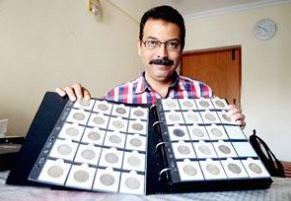 When a 23-year-old Gev Kias bought his first booty of 15
"antique" silver coins off a street vendor at Flora Fountain in Mumbai, he congratulated
himself for striking a cool deal. It was only later when he sat fingering them on his way back to
Pune that he noticed that the silver colour was rubbing off on his fingers. "I wanted to go
and hammer that guy. Then I realised that it was my fault. I'd gone and bought the coins
without any knowledge about them whatsoever," says the now 46-year-old automobile engineer-
turned-numismatist, who works as the in-house advisor and grader of Numismatic Guarantee Service
(NGS) of India — the country's first professional grading and certification service for coins
and paper money of South Asia.
When a 23-year-old Gev Kias bought his first booty of 15
"antique" silver coins off a street vendor at Flora Fountain in Mumbai, he congratulated
himself for striking a cool deal. It was only later when he sat fingering them on his way back to
Pune that he noticed that the silver colour was rubbing off on his fingers. "I wanted to go
and hammer that guy. Then I realised that it was my fault. I'd gone and bought the coins
without any knowledge about them whatsoever," says the now 46-year-old automobile engineer-
turned-numismatist, who works as the in-house advisor and grader of Numismatic Guarantee Service
(NGS) of India — the country's first professional grading and certification service for coins
and paper money of South Asia.
The fraudulent experience however served to ignite what has turned out to be a lifelong passion. He made inquiries and eventually met another coin collector, who helped give direction to his radarless drive. "He chided me for buying coins off a street vendor and gave me books to study," says Kias, who began by collecting 56 British India coins dated between 1835 and 1947. And just when he thought he'd made the "coin collector" grade, his mentor laughed and told him that, next, there were coins to be collected mint wise (according to the mint of their origin — Calcutta, Bombay or Madras) and then die wise (variations of which make a coin rare).
Today Kias is considered to possess one of the best collections of British India coins and has more than 1,500 varieties dated between 1835 and 1947, from the reign of King William IV to George VI — in all denominations and metals (the most rare ones come in silver). What's more, he's now working on a book that would give comprehensive information about British India coins.
"The earlier books, written by stalwarts like F Pridmore and D Chakravarty, don't cover many coins as they had not seen them. My book will give all the updated information, essential for future collectors," shares Kias, adding that the book would hit the market by September next year. Kias also teaches as visiting faculty at Mumbai University, where he instructs post graduate students about British India coins.
To read the complete article, see:
A
COLONIAL COFFER
(www.ahmedabadmirror.com/others/specials/A-colonial-coffer/articleshow/45000168.cms)

Archives International Auctions, Part XXI
4th Annual Wall Street Coin, Currency & Collectible Show Auction
Federal Fiscal Documents & Security Printing Ephemera
Highlights include:
- Lot 759 Palestine Currency Board, 1929 High Grade Issue
- Lot 1053 British American Bank Note Company Engravers & Printers
- Lot 400 Richmond and Petersburg Rail Road Company, 1870 Specimen Bond
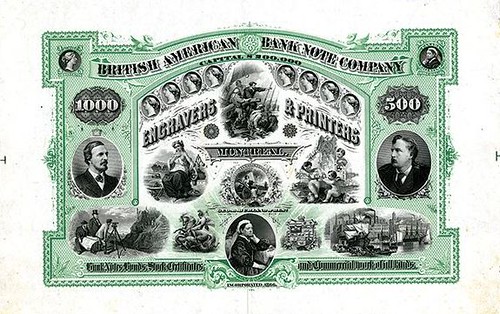
1580 Lemoine Avenue, Suite #7
Fort Lee, NJ 07024
Phone: 201-944-4800
Email: info@archivesinternational.com
WWW.ARCHIVESINTERNATIONAL.COM
BOOK REVIEW: KENNEDY WORLD IN MEDALLIC ART
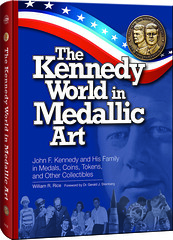 This book dramatically exhibits the fun
you can have with medals and forming a medal collection. Adding to a collection with related
collectable objects – called associated items – increases that collector pleasure all that much
greater. That is what author William R. Rice has done for the reader as he shares that pleasure to
the extreme in his new book, The Kennedy World in Medallic Art.
This book dramatically exhibits the fun
you can have with medals and forming a medal collection. Adding to a collection with related
collectable objects – called associated items – increases that collector pleasure all that much
greater. That is what author William R. Rice has done for the reader as he shares that pleasure to
the extreme in his new book, The Kennedy World in Medallic Art.
Some might say Bill Rice has done for John F. Kennedy what Fred Reed has done for Abraham Lincoln in his two books on Lincoln collectables, all of which were published by Whitman. These are books to read and to savor. I hope this is a trend that continues in the future with other medal topics. Rice’s Kennedy book could thereby serve as a model for future medal authors.
This book is not a catalog, although it has a 49-page listing of 2,837 Kennedy medals. The scope is that large. It continues the catalog numbering system established by Edward Rochette, who compiled and wrote the first book on medallic Kennediana in 1966.
Because of its length the catalog listings are bare bones -- name, size, composition and a very brief comment. The one-medal one-line list contains all varieties known to the author. However, the author relates there may be another two to three hundred more Kennedy medals still to be uncovered.
Collectors will undoubtedly demand a second edition with further data, such as who made the item, artist and producer and the notable events in its creation, all the medal lore of collector interest The author states he has a lot of this data already, it just wouldn’t fit in the first volume. Three features dominate this book, notably: the absolutely stunning photographs, the artistic layout, and the wide diversity of the associated items Bill Rice has gathered to supplement his medals. This includes news photographs and articles, drawings, letters, posters, jewelry items, advertisements, medal leaflets, statuettes, paperweights, cameos and cloth patches. All this in addition to badges, decorations, stamps, covers, post cards and paper money you might expect to find included.
The high quality photographs are the work of the author, a 40-year professional photographer. He has gathered images from both institutions and private collectors – duly noted as Contributors – and his own collection, first started with a gift of a Kennedy medal from his father in 1963.
Even with the such quality photographs, medals of varying medallic quality are shown. High quality pieces – created by top artists, as Paul Manship’s Inaugural medal, Ralph Menconi’s Presidential Medal, Gilroy Roberts' Presidential Series Mint Medal – are contrasted with medals hastily designed and crudely produced.
Perhaps Kennedy would have liked the democratic cross section of his medallic art, allowing all to express their adulation of a U.S. president. Many of these later medals exhibit portraits of the 35th president in flat relief with an unrealistic likeness.
However, all such medals should be included in a standard work – if they exist they should be included. To the author’s credit he has captured as many of the Kennedy medals which exist or caught up in his net. If, as the author expects, there still may be hundreds more, it does call for a second edition.
When I met Bill Rice at the ANA Boston convention I mentioned to him I had a small version of the Agop Agapop architectural portrait of the president, shown as the frontispiece in Ed Rochette's 1966 book. The original was placed in situ on the wall of the Hyannis Massachusetts Kennedy Memorial, which the author has pictured on page 91.The six-foot relief of that wall portrait had been cast and the plaster original model returned to Medallic Art Company. I stumbled over that giant plaster for the four years I had to visit the storeroom.
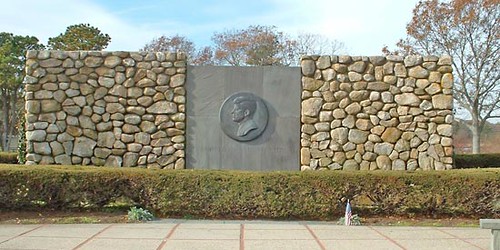
 I had to find my 10-inch Kennedy cast of that giant
portrait listed in his catalog. Sure enough, there it was: K 63A-16. Medallic Art Company called it
the Barnstable John F. Kennedy Memorial Medal. Rochette had listed it as the Lindsay Morris Prize
JFK Medal – an award the artist won of this portrait – a name the current author retained.
I had to find my 10-inch Kennedy cast of that giant
portrait listed in his catalog. Sure enough, there it was: K 63A-16. Medallic Art Company called it
the Barnstable John F. Kennedy Memorial Medal. Rochette had listed it as the Lindsay Morris Prize
JFK Medal – an award the artist won of this portrait – a name the current author retained.
The section on challenge coins is impressive. Because these collectables did not exist when Rochette created his numbering system, Bill Rice had to create a new class of numbers,” KCC.” The Kennedy connection is with the USS John F. Kennedy Aircraft Carrier, which spawned many challenge medals. The 12-page section of these illustrates 92 items, many in enamel color with most produced by Northwest Territorial Mint, a sister firm of Medallic Art Company.
At the end of a telephone interview the author extolled the art department at Whitman Publishing for their excellent artistic layout of the book. He stressed that praise several times. This writer echoes that sentiment.
To read the earlier E-Sylum article, see:
NEW BOOK: THE KENNEDY WORLD IN MEDALLIC
ART (www.coinbooks.org/esylum_v17n37a07.html)
BOOK REVIEW: COINS AND COLLECTORS GOLDEN EDITION
 When all is said and done and Bowers puts away his
typewriter, he will have set the bar so high that few in the present generation of numismatic
writers will dare take up the guidon and strive to supplant him.
When all is said and done and Bowers puts away his
typewriter, he will have set the bar so high that few in the present generation of numismatic
writers will dare take up the guidon and strive to supplant him.
So it is within this context that we pick up the latest entry in Bowers’ long-running and popular franchise Coins & Collectors.
Entitled Coins & Collectors: Golden Anniversary Edition, this newest reworking bears all of the trappings of Whitman’s contemporary design sensibility. A handsome hardcover, Coins & Collectors is a lavishly illustrated, full-color edition that brings Bowers’ prose to life.
It is a celebration of Numismatics in breadth and occasionally in depth. Bowers breezily spans more than 200 years of history, discussing numismatic objects and their backstories while simultaneously proffering his oftentimes first-hand memories of collectors and characters from times past.
And therein lies a great part of the charm of our hobby. In the aggregate, coins are objects through which great stories are told.
Coins & Collectors covers many areas that go beyond the scope of major auction headliners or the most popular collectibles. Among its pages are discourses on Feuchtwanger tokens, ANA medals, minstrel show counterstamps, and 19th century medals celebrating monumental achievements in American engineering.
You’ll also find intriguing nuggets of information and the had-to-be-there backstories behind the pursuit of the 1933 double eagle, the designs of the New Hampshire State and America the Beautiful quarters, and the drama surrounding the SS Central America treasure salvage efforts.
But perhaps more important are Bowers’ reflections on some of the great 19th and 20th century collectors, many of whom he knew and conducted business with. The roster is lengthy, but we’d be remiss not to mention the likes of Norweb, Eliasberg, and the great Thomas Elder–all subjects that Bowers has covered in-depth elsewhere. In the present volume, they serve not only as a spur to further discussion, but also as a reminder for present-day numismatists: it will soon be your responsibility to care for and maintain these stories of coins and collectors.
For now it’s clear: the Old Professor isn’t done yet. The keys still clatter with verve and vigor, and we’re all richer for it.
To read the complete article, see:
First
Read: Coins & Collectors: Golden Anniversary Edition
(www.coinweek.com/featured-news/first-read-coins-collectors-golden-anniversary-edition/)
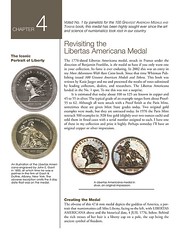
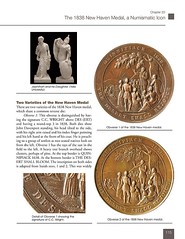
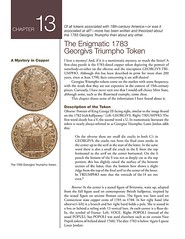
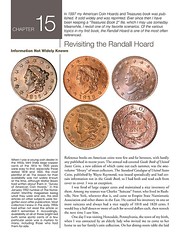
HARVEY STACK ON BOOKS AND THEIR VALUE
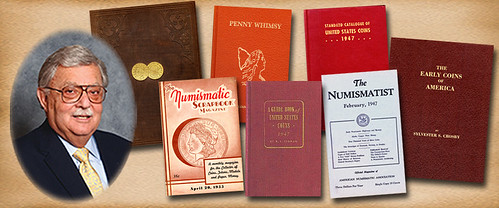
One question I hear quite often from beginning as well as advanced collectors is: "Why buy the book before the coin?". The question often comes from Internet collectors, who seem to think of that as the only source of information. Well, the Internet is good, but at the same time it can’t offer everything.
I was brought up in a numismatic retail shop, run by my father and uncle, which was opened in a recession period. The goal during the 1930s at the first Stack's in New York City was developing a solid base of collectors that the store could serve. So they assembled a vast selection of inventory, with coins from ancient to modern, from the United States as well as the rest of the world, in gold, silver, copper and any other metal. They also assembled a library of reference books, auction catalogs, price lists and photographs. As dealers retired, Stack’s bought entire libraries. Likewise Stack’s would purchase collectors’ libraries, including those assembled by specialists.
Printed information about coins and their history was not always found in the average coin shop, but Stack's tried to have as many books as they could among the items they offered for sale. During the 1930s and 1940s many of the now-famous collectors were building their cabinets. Each had a specialty or two or three, and when these specialized collections were sold, the auction catalogs became current reference books.
Among printed references we had The Numismatist, and publications from the American Numismatic Society. Unfortunately this type of publications often carried very technical information about a series that interested the writer, and rarely had guidance for new collectors on how to build their own collections. One of the early standard references published during this period was the Standard Catalog of United States Coins. It was basically a tabulation of the dates and mints issued by the United States, and showed suggested retail prices. Most other publications had numismatic ads from dealers around the country, but no suggestions how to collect or what to look for.
Some specialized references were more informative and descriptive, but many were either the inventories of collections being formed or were so highly specialized that they made it difficult to learn the basics. Auction catalogs of the period and of the decades before were the basic guideposts for the collector. The dealers or auctioneers who wrote the catalogs (some were extensively illustrated by drawings or early photographs) learned about the coins as they created the catalogs. They were also the experts on grading and other aspects of collecting. In this way the dealer/auctioneer became the teacher, passing this information on to other collectors.
It was (and still is) often said, that one should not try to build an outstanding collection without guidance from books, dealers or fellow collectors. Coin clubs in and around large metropolitan areas became sources for information and these clubs grew rapidly as the information disseminated between members guided collectors in many areas including rarity, grading and more.
To read the complete article, see:
Books and their Value to Collectors, Part 1
(www.stacksbowers.com/NewsMedia/Blogs/TabId/780/ArtMID/
2678/ArticleID/64819/Books-and-their-Value-to-Collectors-Part-1.aspx)
THE BOOK BAZARRE
DAVID FANNING ON THE NUMISMATIC LITERATURE MARKET
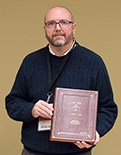 “The market for numismatic literature is strong, and picking
up,” says David Fanning. He and his partner George Kolbe operate Kolbe and Fanning, the premier
dealership for rare and antiquarian numismatic books in the United States.
“The market for numismatic literature is strong, and picking
up,” says David Fanning. He and his partner George Kolbe operate Kolbe and Fanning, the premier
dealership for rare and antiquarian numismatic books in the United States.
When I caught up with them, they were sitting in a room on the third floor, holding a lot viewing for their Saturday sale. On display were hundreds of books, including many great rarities.
A collector of numismatic literature myself, I found many offerings to be of particular interest.
But, I wondered: What makes the numismatic literature market in the United States tick?
“It’s a three-part market for us,” Fanning explained. “Ancients, which [are] always strong, Medieval and Modern Foreign, and U.S. The U.S. literature market is getting hot right now.
“Most of the lots here are U.S.,” he continued, picking up an attractive volume bound in full morocco entitled The Early Coins of America by Sylvester S. Crosby.
“This first edition Crosby catalog has a complicated publication history. It has the original 1873 title page and intro plus the 1875 title page. In addition, it has a rare Edward Maris Woodburytype Plate, Plate XI, which is found in perhaps one out of every 10 copies we see. Also, the piece has a handwritten key to the plate, written by Maris, and a handwritten review of the auction, also by Maris.
“We can’t say for sure, but based on this and other evidence, we believe that this might have been Maris’ personal copy. This catalog was bound, probably in the early 1980s by Alan Grace for Armand Champa. It sold in 1994 to a collector, who recently sold it to us.”
“You don’t really see the use of plates much anymore,” I said, and the two partners tried to think back to the last time that they had seen an auction house produce them with any regularity. Kolbe thought one might have to go back to old Superior catalogs to find ones of a more recent vintage.
Despite their disappearance, collectors still find the inclusion of plates in older catalogs beneficial.
“It’s about determining provenance,” said Fanning.
“For an ancient coin collector, someone with a high-end coin–maybe a $25,000 or a $250,000 ancient coin–numismatic plates are essential. [They’re] essential because, for many of these great rarities, you have to be able to show provenance, for protection. Otherwise, some government might say that you dug it up out of the ground last week and try to seize it from you. If you can show that the exact coin was sold before and here’s a plate of it from a 1904 catalog, then you are good to go.”
To read the complete article, see:
Whitman Baltimore Winter Expo 2014 Coin Show Report: Part 1
(www.coinweek.com/coins/commemoratives/whitman-baltimore-winter-expo-2014-coin-show-report-part-1/)
SS CENTRAL AMERICA SALVAGE: THEN AND NOW
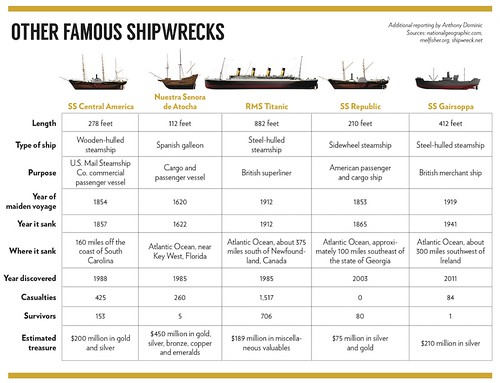
Finding the Wreck: 1989
The following summer they returned to the sites of some of the most promising matches with Nemo, a
remote-controlled device Thompson had engineered to operate in 10,000 feet of water. Evans coined
the name after the protagonist in Jules Verne’s classic science-fiction novel “Twenty Thousand
Leagues Under the Sea.” Nemo had cameras and stereo video that could transmit 3-D images to the
surface. It could rotate 360 degrees, and it had two robotic arms that would respond to the
commands of a technician operating it from above. While exploring the site almost everyone the
previous summer believed was the Central America, they confirmed they had found an 1850s steamship
with a lot of coal. But they didn’t find any gold.
This didn’t sit well with Evans. The site was in a high-probability zone. It was one of the more promising sites they had found. If it was the Central America, there should be gold. Something wasn’t right. So, Evans spent the off season—the winter months of 1987 into 1988—reviewing all the images the sonar scanner produced the first summer at sea, paying particular attention to the images that weren’t included in the Hit Parade. What he found was an image of what appeared to be piles of coal, forming a shape that roughly matched the size of the Central America—better than the other image did, anyway. Though it had been written off as a geological mass, Evans had a nagging feeling this might just be the Central America. If he was right, they had wasted an entire summer and millions of dollars exploring the wrong site. When the group geared up for the next season, Evans told Thompson and Williamson about what he’d found. It was in a low-probability area but en route to the original site, so they decided they might as well pass over it.
The crew, fresh from the off season and prepared for another summer at sea, arrived at the site of the mass that piqued Evans’ curiosity in their newly renovated research vessel, the Arctic Discover. When they dropped Nemo, nobody expected what happened next. Almost immediately, from the corner of the screen, an image of a large iron sidewheel began to creep into view. The room erupted. Shouts of “Whoa!” and “Oh my God!” echoed throughout the control room. Awestruck, Nemo’s operator John Moore began to proclaim, “You know…” and, in unison, the entire crew finished, “what that is!” Moments later, Nemo was inches from crashing into a mast extending straight up into the water. On their first dive of the season, they had hit the target dead center.
Bob Evans Returns: 2014
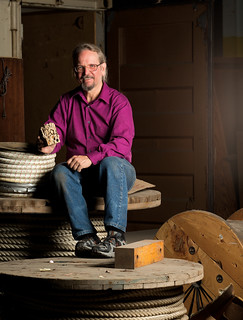 Bob Evans stands on the Odyssey Explorer with his hands in the
front pockets of his blue jeans, his graying hair tucked beneath a canvas cap and pulled into a
thin pony tail. The eyes behind his glasses are bright and wide. He rocks forward in his sneakers,
talking excitedly of the impending trip to sea. Evans is a geologist and a historian—and he is
positively giddy.
Bob Evans stands on the Odyssey Explorer with his hands in the
front pockets of his blue jeans, his graying hair tucked beneath a canvas cap and pulled into a
thin pony tail. The eyes behind his glasses are bright and wide. He rocks forward in his sneakers,
talking excitedly of the impending trip to sea. Evans is a geologist and a historian—and he is
positively giddy.
Unlike the rest of the Explorer crew, 60-year-old Evans is not embarking on this journey for the first time. This is a homecoming. He’s been to the Central America, explored the caverns of its decay, seen artifacts frozen in time, marveled at colonies of sea creatures growing on castles of gold and held the precious metal when it was hauled to the surface. He’s heading back to the site to finish what he and a team of other scientists, oceanographers and treasure hunters started 25 years ago but never completed. He’s going back to finish the story.
“I am thrilled to be going back to this shipwreck,” he says. “Absolutely thrilled. This has been a project that I have worked on and dreamed about and studied in great detail for 30 years. This is a dream come true.”
When Evans left Charleston in April, the trees were just beginning to bloom. Their leaves were already changing color and falling off by the time he returned in September. He had worked the night shift on the Odyssey Explorer—9 p.m. to 9 a.m.—and saw more of the moon than the sun. Still, his fair skin was red and raw as he recounted his summer at sea during an interview in September. Ironically, he wasn’t sunburned while he was on a ship in the middle of the ocean. Rather, it happened the first day he was back on his farm in Muskingum County, mowing the fields, cutting down a maple tree, tending to the horses and sheep and chickens. Evans is spry for 60—heck, he’s spry for 50—and he didn’t stay idle for long, despite his arduous summer.
Though work at sea is demanding, returning to the site of the Central America was a delight for Evans. It was the opportunity to finish what he started—an opportunity he never thought he’d have again.
“I had given up hope that this would happen,” he says, his voice thick with emotion. “It has been very fulfilling.”
Finally, after more than 20 years, he was able to see what had become of his experiments. He holds up a small block of wood—jagged on its sides and nearly hollowed out with cylindrical holes. This is what remains of the pine 4-by-4 they planted in the sediment in 1990. It was 3 feet tall then; now, it’s no taller than 6 inches. The round tunnels were carved by shipworms, which are actually a species of clam, like the ones that consumed the entire ship. Judging by the state of the experimental piece of wood, it didn’t take them very long.
The shipwreck is not only scientifically significant. It’s culturally significant. It is a time capsule, a period snapshot. Over the summer, the Odyssey Explorer crew found thousands of artifacts buried in the sand. A clay pipe, a miniature chess piece. A ladies comb, a spoon. They even found parts of a music box. Evans, a pianist, plans to use the impressions in the drum to decipher the tune it once played.
Most telling were the photographs. Portraits of young women, of husbands and wives, of mothers and their children. Lifeless but preserved. They are the loved ones of passengers aboard the ship’s final voyage. They are the survivors. They are the victims.
“To see people’s faces staring up at you from the bottom of the sea, it’s startling,” he says. “Talk about humanizing what it is that you’re working on.”
To read the complete article, see:
Man Overboard: Tommy Thompson, a Ship of Gold and the Columbus Investors Still Looking for
Treasure
(www.columbusmonthly.com/content/roundups/2014/11/man-overboard-a-tale-of-tommy-thompson-a-ship-of-gold-and-the-columbus-investors-still-looking-for-treasure.html?page=?page=all)

VASILOPITA TOKENS
Regarding our discussion of coin and medal shapes, David Powell writes:
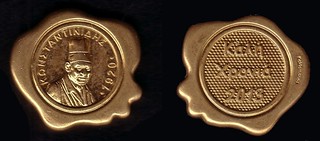 OK, what shape is this? It is a Vasilopita
{Basil's Bread} token, associated with Greek New Year tradition; not that all of them are this
shape, this is just a modern design. I understand that each family makes a special loaf or cake for
New Year, and that exactly one lucky token is baked into it for someone to find.
OK, what shape is this? It is a Vasilopita
{Basil's Bread} token, associated with Greek New Year tradition; not that all of them are this
shape, this is just a modern design. I understand that each family makes a special loaf or cake for
New Year, and that exactly one lucky token is baked into it for someone to find.
To read the earlier E-Sylum article, see:
MORE ON SHAPES OF COINS, TOKENS AND
MEDALS (www.coinbooks.org/esylum_v17n44a11.html)
QUERY: WHAT IS THE DEFINITION OF BRONZE?
Dave Baldwin writes:
I would like opinions/comments on what 'bronze' means to numismatists. I recently had the opportunity to have several medals subjected to xray flourescence and the results are rather interesting. A few did show as 100% copper but most were not.
Bronze pieces are usually described as chocolate brown with copper pieces being more red. But two Buchanan Residence medals came up with the redder piece being 99.46% copper, .32% platinum, .17% zinc and the brown piece 99.68% copper, .22% platinum. And bronze is usually described as an alloy of copper and tin yet none of the ones tested showed any trace of tin. Small amounts of zinc were found and almost always some platinum.
Online searches for definitions of bronze are pretty inconclusive and it seems the term copper alloy is preferred. So as numismatists what do we mean by bronze and how is that determined? I have also seen the term 'bronzed copper', is that bronze or a copper piece with bronze plating? Any help would be much appreciated.
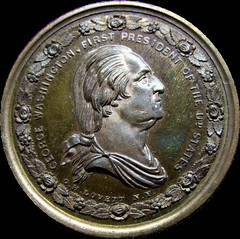
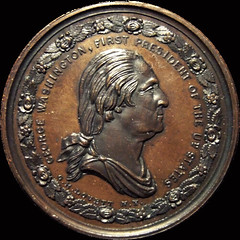
Medal 1: 99.73%copper, .2% zinc
Medal 2: 97.18% copper, 2.78% zinc
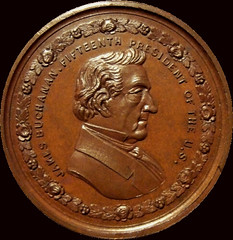
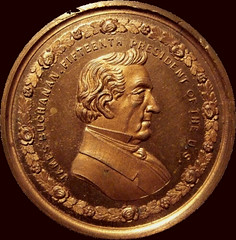
Medal 3: 99.68% copper, .22% platinum
Medal 4: 99.46% copper, .32% platinum, .17% zinc
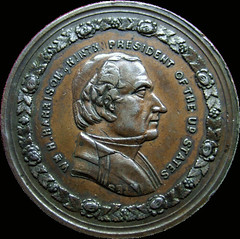
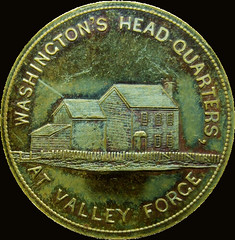
Medal 5: 99.54% copper, .32% nickel
Medal 6: 100% copper
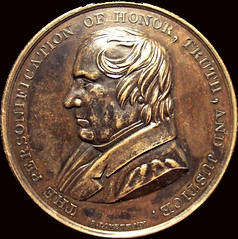
Medal 7: 99.11% copper, .4% iridium, .31% nickel
Dave adds:
It is interesting being able to get accurate descriptions for the tokens and medals. One piece that was described as "nickel" turned out to be 100% silver although it did not look like it at all. And it is free! I have a contact at a precious metal recycler and every few months I take a handful up to put through the machine Takes about 15 seconds and he says the machine is very accurate. Next time I am going to take one up he has done already to see if the reading is the same.
NOTES FROM E-SYLUM READERS: NOVEMBER 2, 2014
Correction: Tsadik Kaplan
Ira Rezak writes:
In David Alexander's review of Tsadik Kaplan's book, for some reason or other, Tsadik is referred to as "Cohen".
To read the earlier E-Sylum article, see:
NEW BOOK: JEWISH ANTIQUES
(www.coinbooks.org/esylum_v17n44a04.html)
Hunt's Ancient Coin Collection
Regarding billionaire silver baron Nelson Bunker Hunt, Denis Loring writes:
Hunt's financial woes required him to sell his incredible collection of ancient coins. For some reason, I was on Sotheby's preferred list, and was invited to a by-invitation only showing of the collection. I still remember the Greek silver. Each one was like a miniature sculpture. Magnificent.
To read the earlier E-Sylum article, see:
ARTICLE PROFILES SILVER BARON NELSON
BUNKER HUNT (www.coinbooks.org/esylum_v17n44a19.html)
Plated Auction Catalogs Online
Ron Guth writes:
I was rooting around on the Interweb and came across a plated Mougey (Elder) and a plated Lyman (Chapman) on the Library of Congress website. I'm hoping they have other catalogs for those of us who like to do the research but can't afford these precious items. The plate renderings are not the best in the world, but some plate-matching can be accomplished.

Lyman catalog plate
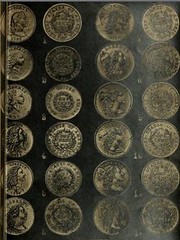
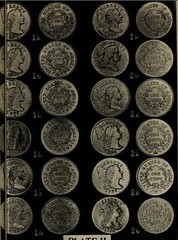
Mougey catalog plates
To read the catalogs, see:
Catalogue of the forty-third public
sale magnificent rare coin collection of the late Peter Mougey (1910)
(https://archive.org/details/catalogueofforty00moug)
Catalog of the splendid collection of
silver & copper coins of the United States formed by John P. Lyman (1913)
(https://archive.org/details/catalogofsplendi00lyma)
Mark Twain on Conjecture
Bill Eckberg writes:
The discussion about the stars on the Wright quarter pattern reminds me - as, alas, does too much that passes for numismatic research - of Mark Twain’s quote from Life on the Mississippi: “One gets such wholesale returns of conjecture from such a trifling investment of fact.”
To read the earlier E-Sylum articles, see: QUERY: JOSEPH WRIGHT 1792 PATTERN PHOTOS
SOUGHT (www.coinbooks.org/esylum_v17n42a06.html)
NOTES FROM E-SYLUM READERS: OCTOBER
19, 2014 : Counting the Stars (www.coinbooks.org/club_nbs_esylum_v17n43.html)
MORE ON THE JOSEPH WRIGHT 1792 PATTERN
(www.coinbooks.org/esylum_v17n44a15.html)
Kankakee Kontinued
Web site visitor Luke Bates writes:
I grew up in "K3" and stumbled across your site. Thought you might like to know a few more songs that mention Kankakee.
1. Andrew Osenga "Kankakee"
2. Martha White "Kankakee"
3. Chris McKnight "Nothing On Me"
4. Tom Waits "Circus"
5. Myshkin's Ruby Warblers "King of Kankakee"
6. Sufjan Stevens "They Are Night Zombies!!! They Are Neighbors"
7. Artist Unknown "Jumpin Judy" - an old prison song
To read the earlier E-Sylum article, see:
QUIZ ANSWER: CITY OF NEW ORLEANS
(www.coinbooks.org/esylum_v16n53a08.html)
Penny Wise & Book Foolish
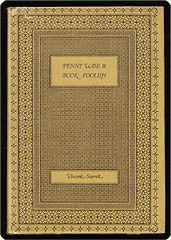 Jim Neiswinter writes:
Jim Neiswinter writes:
Went to a book fair today at Hofstra U. with Chuck Heck. He pointed out a book with an interesting title: Penny Wise & Book Foolish written by Vincent Starret in 1929 . It's about finding 1st additions. It cost 50X the original $3 price.
THE BOOK BAZARRE
ELECTROTYPES OF CHARLES ENDERS JR.
Dave Hirt writes:
While reading last week's post on electrotypes, I remembered that I have a pamphlet I estimate from the 1870s offering them for sale by one Charles Enders Jr, who signs himself "Numismatist." He makes the rather brazen claim, "The workmanship is so skillfully executed that they cannot be fully appreciated until seen, and are calculated to deceive others than experts."
He lists for sale early Massachusetts & Maryland silver, Early federal and state patterns. American tokens, Higley, Chambers, New England & Carolina Elephant etc. US Half Cents & Large cents, and early medals.
I have had this for many years. I don't remember where I got it. The last one I saw sold was 20 years ago, for around $100.
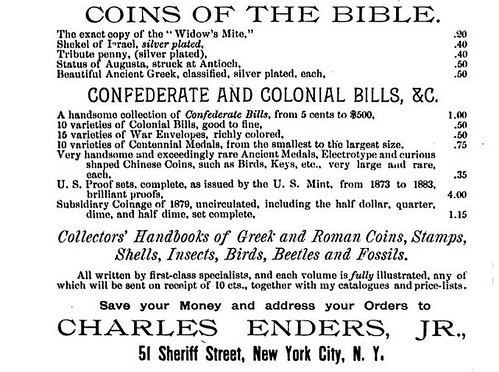
To read the earlier E-Sylum article, see:
NOTES FROM E-SYLUM READERS: OCTOBER 26,
2014 : Query: Samuel H. Black Electrotype Plate (www.coinbooks.org/esylum_v17n44a09.html)
SAMUEL H BLACK'S STORECARD TOKENS
Samuel Black 1859 Storecard
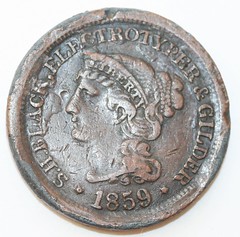
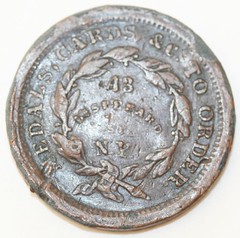
Samuel Black 1860 Storecard
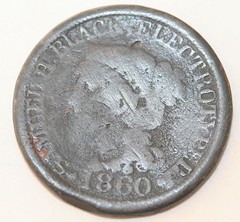
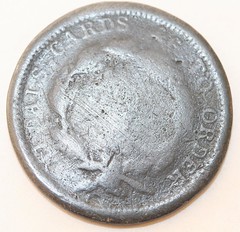
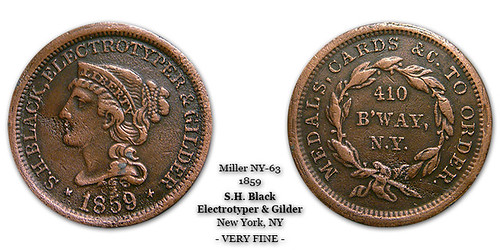
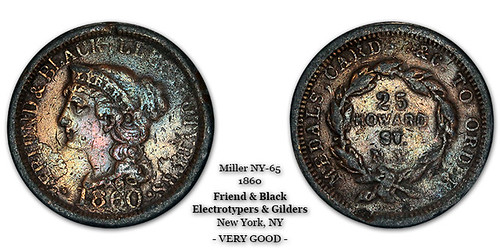
Aaron writes:
The first specimen is listed as Miller NY-63 and dated 1859. It was photographed using overhead incandescent lighting.
The second specimen is listed as Miller NY-65 and dated 1860. It was photographed using axial lighting. Given that there exists both Samuel H. Black tokens, and Friend & Black tokens both dated 1860, it would seem that sometime in 1860 Black went into partnership with Friend.
Both specimens were electrotypes, with their core planchets being made of lead. The softness of the lead is apparent in the deformities of both specimens, but most especially in the NY-65 piece.
Of the multiple specimens that I have in the cabinet, these are the best examples because they still possess the majority of their copper plating and are the least deformed.
On Saturday Aaron added:
I picked up a Miller NY-64 today at the Baltimore show. Despite being VF-20, I believe it provides a good view of the underlying planchet; the majority of the copper plating is either missing, or never adhered properly. Indeed, that’s why I bought the example today. Perhaps your readers will find this third specimen, without most of its copper plating, also interesting.
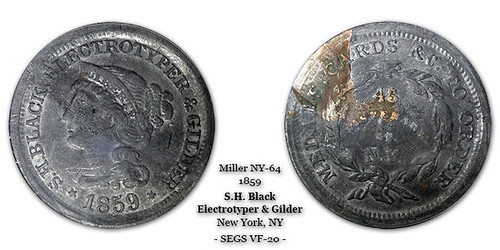
To read the earlier E-Sylum article, see:
NOTES FROM E-SYLUM READERS: OCTOBER 26,
2014 : Query: Samuel H. Black Electrotype Plate (www.coinbooks.org/esylum_v17n44a09.html)

DICK JOHNSON ON MARKETING MEDAL HOARDS
No problem selling coins whenever a hoard of similar items are discovered. With known prices and large demand the price can remain fairly stable. Most any dealer can market coin hoards. Not so with medals. Supply and demand is the operative term, it certainly applies here.
The recent discussion in The E-Sylum of the National Medallion Plaque (the large version) made by electrolysis by Samuel H. Black in 1859 comes to mind. New York token and medal dealers Rossa and Tannenbaum discovered a hoard of these which had remained intact for over a century. At a New York City flea market they acquired the entire hoard, some twenty pieces or so. Had they publicized the fact they had that many for sale the price would have dropped dramatically.
The two dealers wisely eased these into the collectors' market. Never showing more than one at a time at shows or revealing the number they had on hand. It probably took them a decade or so to sell them all but they were able to maintain a stable price. Previous owners of the piece did not observe a drop in "current market value" to use an appraisers' term.
Medals are sold one at a time generally to topic collectors. A gradual increase in value can be expected over time but this is upset when a large supply is available with a somewhat limited demand. Collectors are very savvy and sense this. They often detect when a large supply still exists.
There is a name for this, a vocabulary word of the week: OVERHANG. When overhang exists and collectors are aware of this the price does not rise, and often drops.
I can cite many examples of this. The Ohio Sesquicentennial Medal of 1953 is one for instance. I am often asked if the Medallic Art Company would buy back any medal they made and the answer is NO. The company does not deal in past issues.
If an organization has a quantity of unsold medals they should NOT shop around. Offer it to one dealer who is the best prospect. Offer the entire quantity. Do NOT split it up, selling it to more than one dealer. Do NOT publicize in any way the quantity sold, who acquired it, or even the quantity existed at all. Allow that dealer to sell one piece at a time, not to disturbed the market value, even if it takes him a decade to do so.
To read the earlier E-Sylum article, see:
NOTES FROM E-SYLUM READERS: OCTOBER 26,
2014 : Query: Samuel H. Black Electrotype Plate (www.coinbooks.org/esylum_v17n44a09.html)
ON THE 1976 BICENTENNIAL CELEBRATIONS
In answer to Kay Freeman's comment on the lack of a celebration of the 1976 Bicentennial we have one person to blame. It was President Richard Nixon - to his shame, he squashed the plan for any world's fair that year.
Major cities all made proposals to hold a 1976 Bicentennial World's Fair in their city. Philadelphia because it was where all the action was 200 years earlier, Chicago because of the success of their 1892-3 and 1933 World's Fairs, New York City because they had a ready-made location where the 1939 and 1964 Fairs were held, and even Miami Florida they said because of the better weather.
Nixon delayed making a decision until it was too late for any successful planning. When finally pressed he indicated every city should have their own (thus no city got the approval). Shame on you, Nixon.
The 1892-3 Chicago World's Fair was a fascination for collectors, and numismatically so, because it was open season for collector's items. Anyone could have a medal made and issued for the fair. Over a thousand have been recorded. Nathan Eglit made the initial attempt to list them all in is 1963 catalog, Columbiana.
As a Chicago lawyer he had the resources to gather these in which the Chicago area was a rich source of these appearing on the market. He gathered these for years. After he died his son consigned a large group of these for me to auction (double sale Johnson & Jensen sale #15-16, March 25, 1961). I thought that was his collection. Later I learned these were his duplicates! Joe Levine auctioned his collection (Presidential Coin & Antique Co. sale #52, May 27, 1992).
Like Kay I enjoyed July 4, 1976 in New York City. I brought my family to the city where we established an overlook point on the bridge half a block down the street from the old ANS building. The Tall Ships display on the Hudson River was a full day's attraction. Until the rains came. The car was only a half block away but we were drowned in that short distance. However, the day was worth every minute and every discomfort!
In our conversation at the last Nummis NOVA dinner, Tom and I shared a hope that America would celebrate our 250th anniversary with the kind of exuberance and unanimity that we exhibited in 1876. Where I was (and still am) coming from is expressed in a this sidebar from my book:
The efficient involvement of the Federal government in exhibition business in the 1870s contrasts sharply with the fiasco of our Bicentennial celebration 100 years later. As Lynne Cheney wrote in her essay “1876: The Eagle Screams”: “Witness our own inability —unwillingness, perhaps—to put together a similar Bicentennial celebration. Philadelphia worked on Bicentennial plans for sixteen years, twice as long as it took to free the colonies from England, making and unmaking plans for an exhibition, discarding one site after another, trying to please social activists who wanted jobs for the poor instead of a party, businessmen who wanted the revenue from an exposition, homeowners who didn’t want the disturbance.”
I have no desire to ignite a controversy over something that I view as non-partisan patriotism (though I would relish the debate). I realize that even using these two words in a single sentence betrays me as a hopeless and undesirable neocolonial romantic. I personally doubt that America will muster enough patriotism and non-partisanship to match for its 250th anniversary what it accomplished for its 100th. Ms Freeman’s comment is a case in point, the first confirmatory nay-saying shot out of the barrel.
Besides, I do not remember saying that we should emulate the Sesquicentennial, nor that any local celebration, such as that in New York or anywhere else, was unworthy.
To read the earlier E-Sylum article, see:
U.S. SEMIQUINCENTENNIAL CELEBRATION
THOUGHTS (www.coinbooks.org/esylum_v17n44a13.html)
QUIZ ANSWER: RUGOSITY
In last week's issue Dick Johnson asked, "What 20th century U.S. circulating coin did Walter Breen describe as displaying rugosity?" Pete Smith writes:
From Walter Breen's Complete Encyclopedia of U. S. and Colonial Coins, page 257: "Gone is much of the rugosity of Black Diamond's hide, gone too are many details of the Indian's hair, wrinkles, and feathers."
Dave Lange writes:
I recalled that word immediately from when I was writing the first edition of my Buffalo Nickel book, though I resisted the temptation to include it in my own descriptions. Walter Breen was decrying Charles Barber's habit of smoothing out the fields of all new coin types that came his way from outside sculptors. The deeply textured surfaces were in vogue among artists of the time, as they diffused the light and permitted easier viewing of the design. The prevalence of sandblasting or otherwise imparting matte surfaces to coins and medals was an extension of this same trend. Unfortunately, Mr. Barber's conventional thinking found such practices objectionable, and he replaced the textured fields with smooth, shiny ones at every opportunity. The Type 2 1913 nickels and all succeeding pieces were so treated, as were the dimes, quarters and halves produced midway through 1917 and thereafter.
To read the earlier E-Sylum article, see:
VOCABULARY TERM: MEDALLIC OBJECTS
(www.coinbooks.org/esylum_v17n44a12.html)

MORE ON PLAYING CARD MONEY
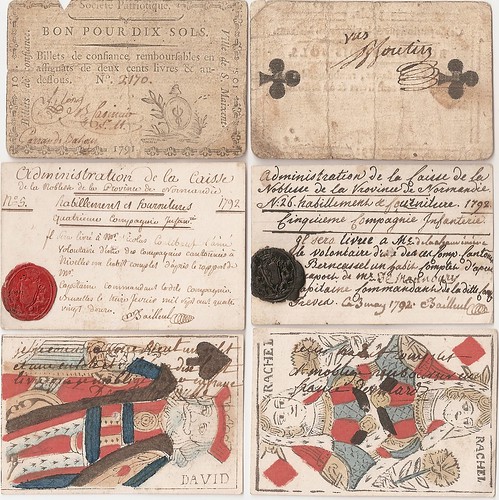
I was happy to find the article about the Canadian collector who acquired what appear to be two IOUs or redeemable chits for bottles (?) of rum, created using playing cards, attributed to a Canadian merchant. I happen to have a large exhibit I've been showing at SoCal venues this year, which I plan to spring on the ANA when it convenes in Anaheim in 2016, entitled "Variations on a Theme of Playing Card Money."
First, to attract the attention of US collectors, I provide background information on the extremely rare and valuable government-issued Canadian playing card money. I show a recent set of colorful commemorative coins, but only a photo of an actual example. (I don't own any but in my defense I cite auction prices in 4 and 5 figures.) However, following that intro are two halfway-decent (no tape) pieces of very rare playing card money issued by a French municipality (billets de confiance) during the Revolution.
Those are followed by my large collection of playing card promissory notes filled with counter-writing not only signed and dated, but bearing intact wax seals from an expatriate French nobleman who was supplying the Monarchist resistance back home in Normandy with mercenary soldiers from Brussels.
That section is followed by paper and porcelain notgeld and a coin which feature card games with local ties, to wit: Altenburg, Germany - Skat; and Switzerland - Jass; together with multiple decks of those cards. Finally, I show a deck of modern gold-foil playing cards that "reflect" 500 euro notes. I was embarrassed to include that cheesy tail end of the exhibit, but of course it attracted the most audience attention by far! I hope the judges at the ANA are more impressed by the historic repurposed hand-painted antiques, which got me going on this.
In my scan of six playing cards, the top two should definitely qualify as "playing card money," since they are local government issues from 1791. The municipality was Saint-Maixent, in Deux-Sèvres département. The very first card is a king of clubs. The French specialized book about such things, Les billets de confiance de la Révolution française 1790 - 1793, Maurice Kolsky, 2004, estimates that there are three or fewer examples of each denomination of these pieces known (R5), but I doubt that is correct.
The other four are fronts and backs of some of my promissory card/notes, issued from Brussels and signed and dated in 1792 by the marquis of Bailleul, Angerville-Bailleul, Haut-Normandie, to be conveyed by mercenaries into Normandy, where they were exchanged for military uniforms. I translated the text on both sides of one of the cards for my exhibit.
To read the earlier E-Sylum article, see:
ARTICLE PROFILES CANADIAN COLLECTOR GEORGE
MANZ (www.coinbooks.org/esylum_v17n44a20.html)
THE CHIEF THREE FINGERS MEDAL
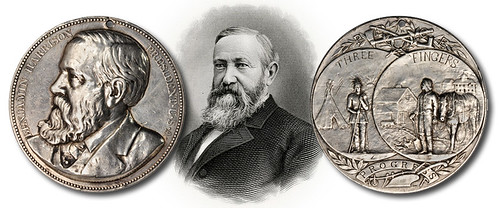
Undated (Circa 1890-1893) Benjamin Harrison Indian Peace Medal. The Only Size. Silver. 76.7 mm, 3.75 to 4.05 mm thick. 3,463.7 grains. Obverse Signed C.E. BARBER F. Julian IP-48.
The Benjamin Harrison medals marked a departure from the oval style medals that had been adopted for the Rutherford Hayes, James Garfield, Chester Arthur and Grover Cleveland administrations. This was reportedly a reaction to requests from a delegation of four Oto and Missouri Indians who visited Washington in 1890. They specifically asked for round medals bearing the portrait of the sitting president.
According to the account published by Francis Paul Prucha in his Indian Peace Medals in American History, the Oto and Missouri visitors were so adamant about the specific shape and size of the medals that they offered to pay the costs of the medals themselves. This was likely their answer to resistance from the Commissioner of Indian Affairs, who would have realized the bureaucratic difficulty of altering the adopted style of the official medals and probably attempted to dissuade them. Nonetheless, the request was made through proper channels to the Mint, and Mint officials complied.
The Director of the Mint requested of the Office of Indian Affairs that they propose a new design for the reverse of the medals. A sketch was supplied which was intended to illustrate “progress” in the Native American’s adaptations to a way of life including “a civilized house and occupation,” though it was considered only a rough attempt to provide an idea of what would be desirable. A design by Charles Barber was proposed, found agreeable to all concerned, and adopted on May 12, 1890. On October 25, 1890, the first of the round medals, five in number, were forwarded to the Oto and Missouri Indians who had made the original request. In November, 1890, 18 more medals were sent to be distributed to members of the Cheyenne and Arapahoe who had agreed to sell vast lands in Indian Territory to the United States.
As noted in Prucha, “some of these medals had the names of the recipients engraved on the reverse.” Five of the seven known medals are engraved to the recipients or to names of other members of the Cheyenne and Arapahoe. The present medal is among them, engraved with prominence, THREE / FINGERS, in letters arcing across the upper portions of the two large circles in the reverse design. Three Fingers, a Cheyenne Chief well documented in the historical photographic record, is not listed among the known original recipients. However, careful study of the medal itself reveals an earlier engraving, largely effaced. In the field below FINGERS can be seen the faint letters of BUFFALO, and just after, very faint remnants of MEAT. It seems, therefore, that this medal was originally Buffalo Meat’s medal, one of the documented recipients.
It is unclear as to why the name was altered, but the medal obviously became the property of Three Fingers at some point. There are superb photographic portraits of him wearing this medal. The men were contemporaries, and are photographed together in images taken in Washington, in 1895. In one of them, they appear alongside Wolf Robe, another recipient of the Harrison medal. Three Fingers is reported to have died in 1917 at the age of 58, and is buried at the City Cemetery at Kingfisher, Oklahoma. Buffalo Meat is a much better documented character. He was born in 1847 or 1849, depending upon the source, and also died near Kingfisher, of tuberculosis, in 1917.
The 1895 photograph of Buffalo Meat, Three Fingers and Wolf Robe is interesting in the subtle clues it yields. Buffalo Meat is dressed in European attire, a black suit, bow tie and broad brimmed black hat. Three Fingers and Wolf Robe are in native Cheyenne attire and only Wolf Robe wears his Harrison medal.
To read the complete article, see:
Newly Discovered Magnificent and Rare Benjamin Harrison Indian Peace Medal in Silver, Presented in
1890 to Buffalo Meat will Make its Auction Debut in the Stack’s Bowers 2015 New York Americana
Sale (www.stacksbowers.com/NewsMedia/Blogs/TabId/780/ArtMID
/2678/ArticleID/64828/Newly-Discovered-Magnificent-and-Rare-Benjamin-Harrison
-Indian-Peace-Medal-in-Silver-Presented-in-1890-to-Buffalo-Meat-will-Make
-its-Auction-Debut-in-the-Stack%E2%80%99s-Bowers-2015-New-York-Americana-Sale-.aspx)
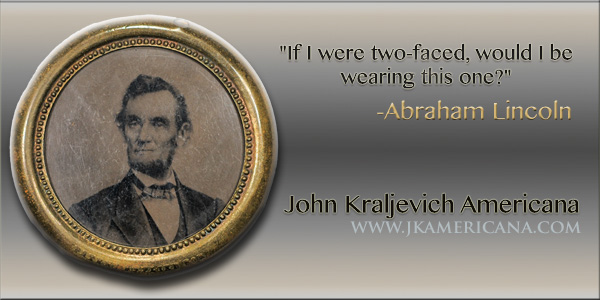
PANAMA CANAL 100 YEAR ANNIVERSARY MEDALS

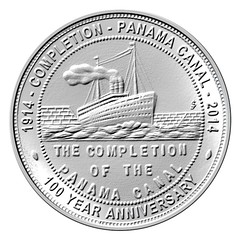
The Panama Canal was completed in 1914, at that time it was considered a technological marvel. The canal was an important strategic and economic asset to the U.S., and revolutionized world shipping patterns. The canal saves 7,800 miles on a trip from New York to San Francisco by sea. The first ship to complete an ocean to ocean passage through the Canal carried 50,000 historical medals to commemorate that event, but only a few hundred of those medals exist today.
This year on the 100 year anniversary of the completion of the Panama Canal a medal has been created to commemorate this significant event in our nation’s history. The medals will be struck by Daniel Carr of the Moonlight Mint.
The obverse design is similar to the 1914 Panama Canal Completion medal which features a female standing on the prow of a ship with outstretched arms, below her right hand is a globe of the eastern hemisphere, below her left hand is a globe of the western hemisphere with a scroll between the two symbolizing that the two hemispheres have been united. It is cataloged as HK 398 by Hibler and Kappen in their reference book on So-Called Dollars published in 1963. The legends and scrolls have been modified to state "1914 - COMPLETION PANAMA CANAL - 2014" and "100 YEAR ANNIVERSARY".
The reverse design is an adaptation of HK 432 from the 1915 Panama-California Exposition, which features a ship sailing through the Canal locks with minor modifications.
The medals are 39mm and will be struck in silver, copper, gold-plated and gold. The silver pieces will be edge marked "ONE TROY OZ .999 SILVER". The Gold will be 1.6 OZ and edge marked "50 GRAMS 999+ GOLD".
This is an exclusive opportunity to order these medals at the pre-order discounted prices. The silver will cost $65 each, copper $10 each and the gold-plated $35. Gold will be approximately $2,350 depending on spot at the time of the order and will have 1.6 OZ of 999+ Gold.
These medals will be carried through the Panama Canal in 2014 as occurred 100 years ago in 1914.
To order medals contact Jeff Shevlin (So-Called Guy) via email SoCalledGuy@hotmail.com or via mail 1894 E. William Street, Suite 4-240, Carson City, NV 89403, or phone # 916-955-2569.
HERITAGE TO OFFER DON PARTRICK COLONIAL COLLECTION
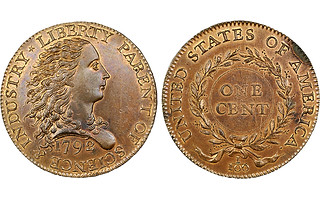 What is being billed as "the finest collection of
colonial American coins ever assembled" is heading to auction, the first sale scheduled for
January 2015 in Orlando, Fla.
What is being billed as "the finest collection of
colonial American coins ever assembled" is heading to auction, the first sale scheduled for
January 2015 in Orlando, Fla.
“This series of auctions is unprecedented in numismatics,” said Jim Halperin, co-founder of Heritage Auctions. “This is an incredible grouping of coins, the likes of which we won’t see again.”
“The name of Donald Groves Partrick is well known to colonial collectors and his cabinet is second to none in the field,” said Mark Borckardt, senior cataloger for Heritage Auctions. “His collection also includes an unprecedented assemblage of 1792 U.S. Mint Patterns and coinage of the Confederacy.”
Part I of the collection includes 12 U.S. Mint patterns of 1792, a total that far exceeds the nine examples in the Garrett Collection auctions, the eight examples in the Norweb Collection sales, and the seven examples held in the Smithsonian Institution.
One of the most fascinating sections of the first sale is the nearly 30-strong grouping of New York coppers, including five Confederatio coppers and 11 Immune or Immunis Columbia coppers. Future auctions will offer, according to Heritage: "additional New York pieces, including two Brasher doubloons, one of the New York variety (the finest known, ex Garrett) and one of the Lima variety; Don Partrick’s incredible Connecticut and New Jersey coppers; and amazing Washingtonia."
The unique 1776 Janus copper in the upcoming Part I sale highlights the Massachusetts copper section, along with an associated Paul Revere token. Massachusetts coppers of 1787 and 1788 include 37 of the 50 known die varieties, while almost 100 Vermont coppers will be offered in Part I, including examples and duplicates of every known die variety.
Coinage of the Confederate states includes one of the four known original Confederate half dollars, pedigreed to Jefferson Davis. A “Jefferson Davis dime” is also pedigreed to the Confederate president.
To read the complete article, see:
Heritage to auction Donald G. Partrick Collection of Colonial coins
(www.coinworld.com/news/heritage-to-auction-donald-g--partrick-collection-of-colonial-coins.html)
ANA EXCELLENCE IN MEDALLIC SCULPTURE NOMINATIONS SOUGHT
NUMISMATIC ART AWARD FOR EXCELLENCE IN MEDALLIC SCULPTURE
Purpose:
The award honors an artist whose cumulative lifetime achievements in the field of medallic
sculpture have been of the highest order.
Criteria:
Nominations should include the name of the nominee, address, contact information, a list of
numismatic accomplishments, a brief biography and photographs of at least five medals – or Internet
addresses where they can be viewed. Nominators should include their addresses and contact
information; artists may nominate themselves. Nominations must be received by noon on January 15,
2015. Nominations should be submitted to Ann Rahn, Project Liaison Coordinator, The American
Numismatic Association, 818 N. Cascade Ave., Colorado Springs, CO 80903, arahn@money.org or Mel
Wacks, Head of NAAEMS Committee, 5189 Jeffdale Ave., Woodland Hills, CA 91364,
numismel@aol.com.
Judges:
The NAAEMS award selection committee is headed by Mel Wacks, and includes David Alexander, one of
the founders of Medal Collectors of America; Jeannie Stevens-Solliman, sculptor and Member of the
Citizens Coinage Advisory Committee; Doug Mudd, Curator at the ANA Money Museum in Colorado
Springs; Mashiko, FIDEM USA Delegate; Donald Scarinci, member of the Citizens Coinage Advisory
Committee and the ANS Saltus Award Committee; and Alan Stahl, Ph.D., Professor and curator of
numismatics at Princeton University.

NUMISMATIC REMEMBRANCES OF EDGAR ALLAN POE
I am aware of only three medals honoring the author.
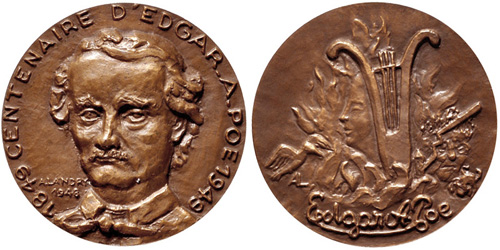
Poe Hall of Fame Medal
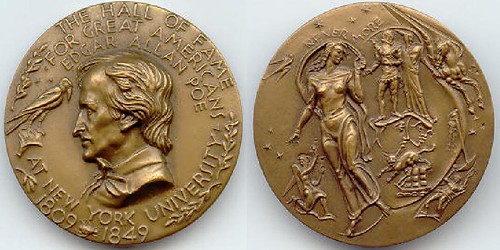
In 1962, the Medallic Art Company started striking a series of medals to honor the inductees. Poe’s medal was designed by Michael Lantz and was struck in 1963. Medals were struck in two sizes. A large 3-inch (76mm) in bronze only, and a small 1¾-inch (44mm) size in bronze and silver. The silver medals were serially numbered.
Poe ANA Medal
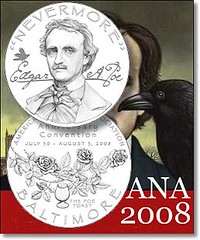 When the American Numismatic Association returned to Baltimore
in 2008, they chose to honor Edgar Allan Poe on their convention medal designed by Jamie
Franki.
When the American Numismatic Association returned to Baltimore
in 2008, they chose to honor Edgar Allan Poe on their convention medal designed by Jamie
Franki.
Franki’s design features a three-quarter view of Poe in high relief. The portrait on the obverse is inspired by an oil painting by Baltimore artist Oscar Halling and “informed by every image I could find,” said Franki. The word, “Nevermore,” immortalized in The Raven, circles the edge above Poe’s head and a small incused silhouette of a raven is perched on his signature, which was taken from an archival scan.
The reverse tells the tale of the annual “Poe Toast,” where for each of the past 59 years on Poe’s birthday, a black-clad figure visits the gravesite and raises a cognac toast. The toaster then leaves a half-bottle of cognac and three roses on the grave. The tradition of the Poe Toaster has apparently stopped after the bicentennial of Poe’s birth in 2009.
To read the complete article, see:
Numismatic
Remembrances of Edgar Allan Poe
(fourthgarrideb.com/2014/10/numismatic-remembrances-of-edgar-allan-poe/)
To read the complete article, see:
Thank You Very Much!
(fourthgarrideb.com/2014/10/1016/)
STILL MORE ON STICKERED SILVER DOLLARS
Web site visitor David Gidcumb writes:
I just ran across your article in one of my occasional searches looking for information on stickered dollars. I have a website devoted to sticker dollars: www.stickeredsilverdollars.com . The website is a work in progress. I have over 80 coins in my collection. I spend a good bit of time researching these coins so it is quite time consuming to add new coins to the website. Like Mishler, I collect anything I have not seen before.
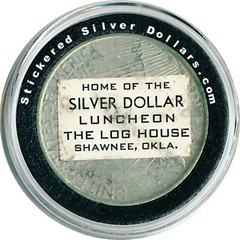
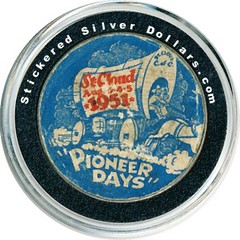
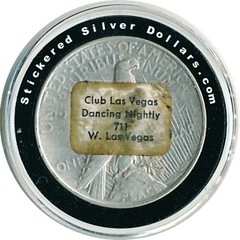

To read the earlier E-Sylum article, see:
MORE ON STICKERED SILVER DOLLARS
(www.coinbooks.org/esylum_v17n42a11.html)
SAVING KEY DATES FROM THE 1980 SILVER MELT
You asked for recollections from those dealers who experienced the Hunt Bros. Silver rush. Here goes:
In 1980 I worked for Gary Young who had a coin store in Oakland, CA. As silver prices rose and the media started to cover the story, people began to come into the store to sell. This soon turned into a flood of customers lined up outside the store. It was just the two of us and we had to lock the door, letting only a few people in at a time. I don't think we sold many numismatic items at the time because our regular collectors didn't want to fight the crowd.
I was busy cutting up 1959 to 1964 Mint and Proof sets to send the silver coins to a refiner. Metal buckets of coins, jewelry etc. segregated by fineness were picked up regularly for shipment. I remember running a quantity of Quarters just purchased from a vest pocket dealer through a coin counter. For some reason I picked out a 1932 coin and turned it over, only to see an S mintmark. I told Gary this would take longer than usual as I wanted to look at all of the coins. I pulled out ten 1932-S coins. At this time no one was looking at dates, just take the scrap value and run!
Later that year Gary sold his long established store along with a good deal of the inventory to another dealer. To this day I don't know if this was just sheer luck or calculated market timing, but soon after his sale precious metals prices crashed and the value of numismatic coins tanked. The store was later closed. Gary bought a ranch in Northern California and basically retired from the coin business.
To read the earlier E-Sylum article, see:
ARTICLE PROFILES SILVER BARON NELSON
BUNKER HUNT (www.coinbooks.org/esylum_v17n44a19.html)
ARTICLE PROFILES ROYAL MINT ENGRAVER LEE JONES
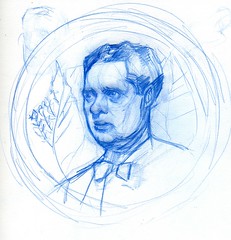
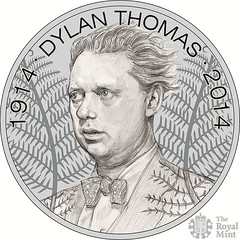
Talented Royal Mint Engraver, Lee Jones, is the artist behind the coin that honours literary giant Dylan Thomas and celebrates the 100th anniversary of his birth. Lee’s design has elicited much comment so, in a recent interview with him, we’ve gone ‘behind the design’ to find out what it was like to design the coin that commemorates one of his heroes.
Tell us a little bit about yourself, Lee…
Well, I’m 40 and I’m from Gelli in the Rhondda. I studied Animation at Glyntaff College. I’ve been an Engraver at The Royal Mint for almost 9 years now. Before joining The Royal Mint I was running my own animation business, working for various companies from London to Canada.
What does your job generally involve and what do you most enjoy about it?
My job involves a lot of design, modelling and tooling work, to not only produce the final designs but the working dies used to strike the coins. You can have a design to go on a coin or you can design a coin – and that’s what we do. To design a coin you have to look at the blank and see how it’s going to work technically as well. I work on both circulation and commemorative coins: for circulation coin designs you have to represent the country and say something about the culture; whereas with commemorative coin designs you can tell more of a story, it’s more art-based.
We understand you are a BIG fan of Dylan Thomas. How did you feel about designing a coin for someone whose work you admire?
I asked for the project! I saw it on the plan and I said ‘I want to do that!’ – so the Chief Engraver awarded the project to me. I would’ve fought to do it! As a fan of Dylan Thomas, I didn’t want to ‘let him down’. I wanted to give a true, in-depth view of him and all the aspects of his character expressed in his works. Interesting fact: when I first started here, one of my apprentice pieces was a ‘Dylan Thomas’ design.
What aspects of Dylan Thomas’ work or personality did you most want to depict?
I didn’t want to present the obvious, such as a profile with a bit of text. I wanted to represent Dylan as that poet, who’s haunted. When I spoke to his grand-daughter, Hannah Ellis, she said ‘you’ve got that haunted look in his eyes, that’s right, that’s how it should be’.
Did you use any images in particular for your inspiration?
I sourced various photos of him; the one of him standing in front of a book-case is what formed the basis of the design. I wanted to capture that ‘1,000 yard’ stare in his eyes in that image.
To read the complete article, see:
Behind the design: Dylan
Thomas 100 (blog.royalmint.com/behind-design-dylan-thomas-coin/)
WAYNE'S NUMISMATIC DIARY: NOVEMBER 2, 2014
This week's numismatic activity was a visit to the Whitman Coin Expo in Baltimore. I went on Thursday October 30, arriving at the convention center about 1:30. I first made a quick pass around the bourse floor. I first stopped to see literature dealer Charlie Davis, who was busy organizing his stock. Sharing the table was Neil Musante, who showed me the manuscript he's working on for a new book on medals. It looks great!
Next I sat down to chat with Charles Morgan of CoinWeek. We talked mostly about my web site project, which was the reason for my next meeting. At 2pm I sat down with Len Augsburger and Mary Burleson of Whitman Publishing in the comfy trio of lounge chairs at the Whitman booth. We had a fruitful discussion, and Mary introduced us to one of the company owners, Charles Anderson. It was a pleasure to finally meet him.
Next, Len and I went upstairs to the Kolbe & Fanning literature auction lot viewing room. George Kolbe was there to greet us. We enjoyed having the opportunity to review such a great grouping of rare numismatic literature. I recognized a number of items which also reside in my own library, but the wealth of plated catalogs was far beyond my meager holdings. We both reviewed the Bathe book on Jacob Perkins, a great rarity which has never been reprinted. I've always wanted one for my library, but the price kept climbing beyond my reach. I congratulate the next owner on its acquisition.
David Fanning soon joined us with the coffee he'd gone out to get. Dave Hirt and his wife Emi also came by. It was great to see them both. Dave's been a numismatic literature buddy of mine for years. We tried to remember when we'd met. Dave believes he met me and John Burns at a Lancaster, PA show one year, and that's probably correct. We recalled the time John and I came down from Pittsburgh to see Dave's library, and all of us visited Frank and Laurese Katen in Silver Spring and toured their numismatic library.
When I got back to the bourse floor I briefly chatted with Julian Leidman and Tony Terranova at their respective tables. John Kraljevich was busy with customers, as usual. I wandered over to the NGC booth to see Dave Lange, then sat down for a while at the Stack's Bowers booth with Harvey Stack. He regularly laments that The E-Sylum isn't seen by a larger number of regular readers. You can do your part by passing the word and encouraging your numismatic friends to subscribe. There's always room for another reader.
Next I went back over to John Kraljevich's table, where, of course, he was still busy. But I enjoyed talking with Erik Goldstein, who was keeping John company behind the table. Soon Bob Evans arrived and chatted with me and Len. He had his famous SS Central America experimental wood block with him. He'd displayed it at the PAN show the week before, but I hadn't seen it close up. This time I got to hold it. Originally a four-foot four-by-four, after 24 years at the bottom of the ocean near the wreck site, it had been eaten down to a 6-inch holey stub, as light as a piece of Styrofoam. Bob had placed four posts in the sediment as an experiment back in 1990.
I asked about the unsold artifacts from the first expedition to the wreck, and Bob informed us that they were still in the good hands of the receiver, and mostly well preserved. Someday an exhibit or museum may come together, but not until all the litigation surrounding the case is finally settled.
It was by now approaching 5 o'clock and I began heading over to the Sheraton hotel for the Coinage of the Americas Conference. When I arrived at the room and spotted Ray Williams, I knew I was in the right place. This year's topic is Colonial Coinage, and an A-list roster of speakers was lined up. Jack Howes came over to say hello and we talked for a bit.
Soon along came local Mike Packard and former local Bill Eckberg, now of Florida. They saved me a seat at a table while I phoned home to my wife. The room was filled with many familiar faces, such as David Gladfelter, Jim Neiswinter and Jeff Rock, whom I hadn’t run into in years.
I took my seat next to Bill Eckberg, and on my other side was E-Sylum reader Jim Glickman, who introduced himself. Also at our table was American Numismatic Society Executive Director Ute Wartenburg-Kagan.
Jim asked about my collecting interests, and I explained how I’d assembled collections of Civil War numismatics including Encased Postage Stamps, Civil War tokens and the Confederate Half restrike. Then we discussed my newer collections of Carnegie Hero medals and Labor Exchange scrip.
As the program began a number of authors were honored for their works on Colonial coinage, including Phil Mossman, Will Nipper and Chris Salmon. All were present to accept. As I'd never met any of them in person before, I waited until a break and introduced myself. It was wonderful to finally meet in person people I'd only corresponded with via email. This in-person interaction is the best part of a coin show, and no electronic medium will ever completely supplant it.
With a long drive to get back home, I was unable to stay for the presentations. Bill Eckberg informs me that "The talks were excellent!" But it was good to get home to say goodnight to my wife and kids, walk the dog and prepare for another work day on Friday. It was a short but delightful numismatic interlude with friends from across the country - the very best part of this hobby we share.
THE BOOK BAZARRE
HOWARD BERLIN VISITS VILNIUS, LITHUANIA
Despite having been in over 54 countries, I had never visited any of the three Baltic countries. While in Helsinki several times, I could barely make out the skyline of Tallinn, Estonia across the sea, but never had the time to take even the ferry for a day trip. This time, I planned a trip of four days in Vilnius and Tallinn, first stopping in Berlin. After spending 24 hours in Berlin, I flew to Vilnius, Lithuania (the original home of my material grandfather and sculptor Victor David Brenner) via an airplane transfer at Copenhagen.
It’s surprising how often I run into a numismatic item without really trying while traveling, some of which have been told in past issues of The E-Sylum. This time in my hotel in Vilnius, I saw this oval table top in the hallway a few yards from my room. What caught my eye as I passed the table was a scattering of coins from quite a few countries. However, none were U.S. coins, not even the lowly penny.
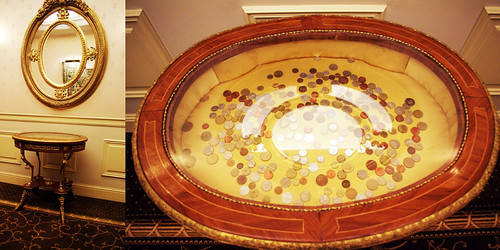
The day following my arrival in Vilnius, I went to the Money Museum of the National Bank of Lithuania, and met with Ms. Vita Beržiunaite, a curator there. I had written about the museum in my book, but nothing beats actually being there.
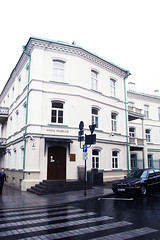 The Money
Museum of the Bank of Lithuania was created in 1999 and is located next to the headquarters of the
nation’s central bank. The high-technology Museum’s exhibition is divided into multiple galleries
on two floors where visitors are introduced to the history of world money, the complicated history
of Lithuanian money, and banking in Lithuania. Basic information is provided in Lithuanian and
English.
The Money
Museum of the Bank of Lithuania was created in 1999 and is located next to the headquarters of the
nation’s central bank. The high-technology Museum’s exhibition is divided into multiple galleries
on two floors where visitors are introduced to the history of world money, the complicated history
of Lithuanian money, and banking in Lithuania. Basic information is provided in Lithuanian and
English.
The History of Money Hall is located in the basement, presents the development of money from its most primitive forms, like grain, cowrie shells, furs, and amber to electronic money. The History of Banking Hall on the ground floor where visitors are introduced to the beginning of Lithuanian banking to the present day. The Contemporary Money Hall showcases banknotes and coins used in different countries today. Visitors can view the banknotes put in special drawers after pulling open the drawer with the name of a selected country. The drawers are connected by special sensors to a computer program that activates the screen on a video wall and presents relevant information about the selected country on it. This information for about 200 countries can also be viewed on the wall using a computer terminal.
Also in this hall, information is presented about the Bank of Lithuania, the nation’s central bank. In the Lithuanian Money Hall, exhibits are able to be seen using a vertical automatic conveyor. Each of the eight conveyors carries plastic cards with the coins of the Grand Duchy of Lithuania, Republic of Lithuania, and other territories which had been in circulation in the country. Pushing a button allow visitors to adjust the height of viewing the cards with the coins, and raise or pull down a lens to view small elements of a coin. In the stationary cases are the commemorative coins of the Republic of Lithuania and in the 20 pull-out cases, the banknotes used in the country from the late 18th century to the present day are on display.
While discussing her museum, Vita mentioned another museum, the National Museum of Lithuania, that had some coins on display. I took a cab to the museum and once inside, I asked the lady at the cashier’s booth about the coins on display. She walked me to the area and when I asked, said I could take some pictures. After snapping a few, another lady, I guess a docent, sounded very authoritative in Lithuanian which I gathered from her shaking her head and waving her index finger – no photography! There are some nice items on display here but I don’t have any real pictures of them. Apparently I needed to get permission from el jefe (the director) to take pictures, but she wasn’t in. “Šudas!” (sh#*t, as they say it in Lithuanian) – Oh well. perhaps on another visit before Putin annexes the country.
The museums of Tallinn, will appear in a following issue of The E-Sylum.
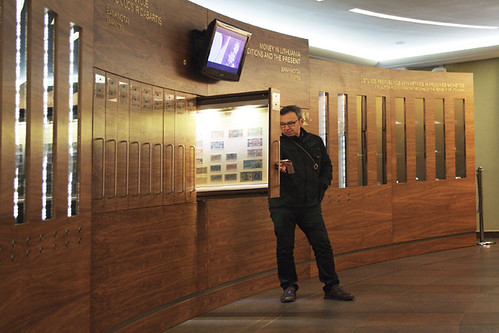
A partial view of the museum’s Lithuanian Money Hall, illustrating the history of Lithuania’s currency. There are sliding magnification lens for coins and pull-out panels for currency.

The museum’s Contemporary Money Hall with over 200 countries represented.
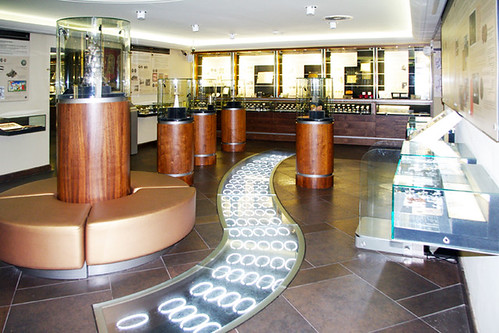
History of Money Hall covering ancient monies to the present.
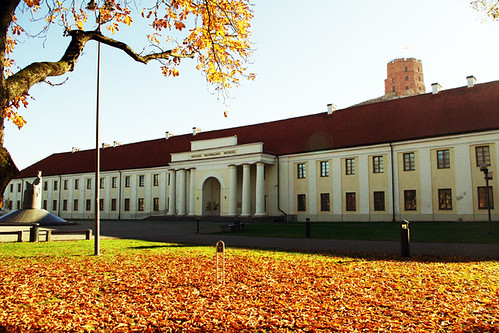
The National Museum of Lithuania, which has a few display case of coins. In the background high up on a hill is the 15th-century Gediminas’ Tower, the remaining part of Vilnius’ historic “Upper Castle” which is depicted on the national currency.
HOWARD DANIEL: A CAUTIONARY TALE FOR MUSEUM DONORS
I am now in my Saigon home and working on my Democratic Republic of Viet Nam Coins & Currency 2nd edition. My printer has already come to see me and ask when it will be ready. I tell him sometime in December for all of my books and it will not change. He is getting pressure from many collectors and dealers for it because they know he is my printer and he is also a collector and an IBNS member.
The item on the case against repatriating museum artifacts reminds me of a past incident;
Many years ago I was went to a particular Southeast Asia national museum to see their numismatic exhibit. When I saw it, I got very excited because I saw a very rare coin in it. That evening at a collector's house, who happens to be very rich, I mentioned seeing the rare coin in the museum. He smiled and told me he had donated it to them so they could show every coin from a short dynasty of kings. I thanked him for doing that so dealers, collectors and the public could actually see the real thing.
A couple of years later, I was back at the same museum and went to their exhibit. The very rare coin had been replaced with a replica! What happened? It was an excellent replica but not authentic and definitely not the coin I saw during my last visit.
That evening in the donor's house, I told him what I saw. He was shocked and it ruined his evening. I apologized for bringing him the bad news. The next evening I received an email from him. He had gone to the museum; saw that his coin was replaced with a replica; and talked to the curator. The curator would not tell him what happened to his donated coin. The donor yelled at him and he finally said that the museum director had found a buyer for it; sold it; and pocketed the money!
My friend will never donate another piece to the museum and will sell the rest of his collection in a future Hong Kong auction, rather than keeping it in his home country. So even when many of these countries have pieces repatriated to them, that does not mean it will not end up back on the international marketplace. There are a few unethical people in a few museums and the rare pieces are slowly going out the back door!
When I read about a particular country pushing for repatriation, all I see flashing before my eyes are those few museum people enriching themselves at a later date by selling it.....sometimes a second or third time! It is not in every Southeast Asian museum but one can ruin the reputation of the others.
To read the complete article, see:
THE CASE AGAINST REPATRIATING MUSEUM
ARTIFACTS (www.coinbooks.org/esylum_v17n44a29.html)
KÜNKER AUCTION SALES 253-257 RESULTS
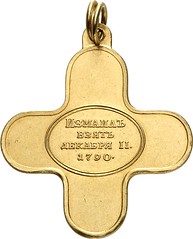
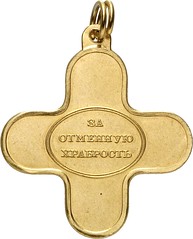

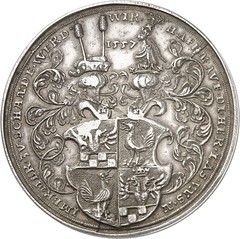
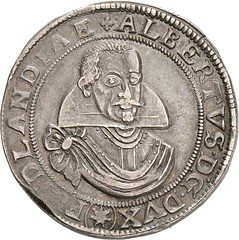
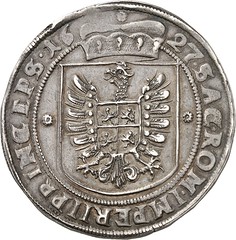
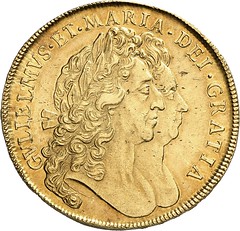
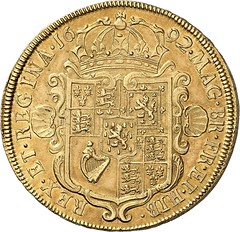

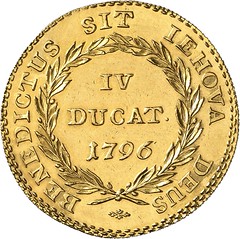
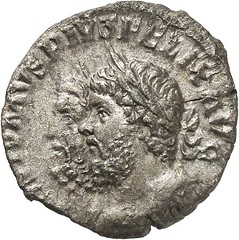
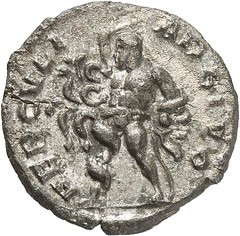
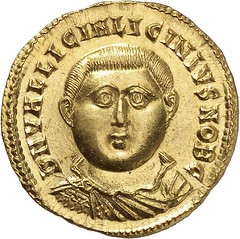
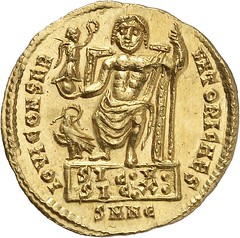
To read the earlier E-Sylum article, see:
KÜNKER AUCTION SALES 253-257
(www.coinbooks.org/esylum_v17n36a24.html)
For more information, see:
www.kuenker.de/en
MASTER COUNTERFEITER FRANK BOURASSA

WHEN YOU GET RIGHT down to it, even a mega-million-dollar international criminal caper is mostly boring shitwork. As Frank Bourassa tells it, his own criminal masterpiece hinged on the events of one morning in early December 2009, a morning he says he spent freezing his ass off in a parking lot, staring through binoculars at the Port of Montreal. On the face of it, the shipment he was waiting for was also dull stuff: boxes of blank paper, nothing more. If the customs agents were to crack into the cartons, Frank was praying that mere paper was all they'd see.
Frank's buddies, in two separate cars, had been surveilling the parking lot for two days, and though they didn't see anything out of the ordinary, he says he was uneasy, knowing that at any time, a bunch of law-enforcement people might swoop down out of nowhere and snatch him up. Frank was right to be paranoid. Indeed, a day would come when a bunch of law-enforcement people would swoop down out of nowhere and snatch him up—but not today. Sensing the moment was right, Frank made a call to another of his guys, a runner he'd hired, and gave him the green light to pull his box truck through the security gates and into the port to load up the shipment.
Before long, the vehicle came rumbling out through the exit lane, and Frank, watching from a distance, got about as excited as a person can get at the sight of a box truck. He had been anticipating this day for nearly two years, though in a larger sense he had been anticipating it since adolescence, when Frank Bourassa launched his varied and profitable career in the lawbreaking sector. His résumé so far, he says, included but was not limited to petty larceny, grand larceny, and grand dope smuggling. But this day marked the real beginning of the grandest, riskiest, most potentially enriching scheme of Frank's life. The convoy now on the move, he and his crew fell in behind the truck.
Frank says he called another friend of his who showed up with scanners and radio wands to check the shipment for bugs. The crew opened the truck. On five wooden pallets sat the future of Frank's criminal enterprise. It was paper of a special kind, made with the same rare cotton-and-linen recipe used for printing American currency. It also bore watermarked images of Andrew Jackson's face and security strips reading USA TWENTY in minuscule type.
The paper was the essential ingredient for fabricating high-grade counterfeit bills that the Canadian police would later describe as "basically undetectable" from the real thing. As soon as the security sweep pronounced the shipment clean, Frank welled up with optimism. "There was no way to stop me from there. I knew I was rich," Frank recalled. "It was the best day of my life." Frank now had what he needed to print hundreds of millions of dollars' worth of fake U.S. currency—and to soon become the most prolific counterfeiter in the history of the trade.
To read the complete article, see:
The Great Paper Caper
(www.gq.com/long-form/the-great-paper-caper)
To watch a great video, see:
This Man Made $250M in Counterfeit Money and Got Away with It*
(video.gq.com/watch/gq-features-this-man-made-250m-in-counterfeit-money-and-got-away-with-it)
To read the earlier E-Sylum article, see:
COUNTERFEITER FRANK BOURASSA
(www.coinbooks.org/esylum_v17n21a30.html)

DESIGNER PURRINGTON REIMAGINES U.S. PAPER MONEY
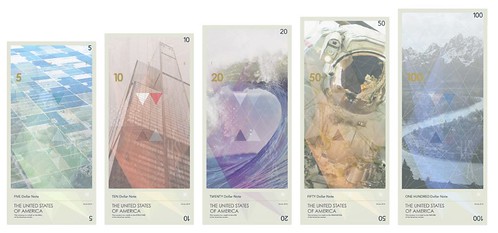
As part of his thesis as a student at the Basel School of Design in Switzerland, Travis Purrington wondered what the dollar would look like with a more modern look. His concept jettisons America's nationalist design language to take a more humanist look at American culture. And it's about time.
The design of the United States dollar has not significantly changed since 1929, when the older, larger notes used at the time--colloquially referred to as "horse blankets")--were shrank down to the smaller greenbacks we all know today. Since then, there have been numerous minor revisions to the design of the dollar, mostly as anti-counterfeiting measures; 1957 saw the addition of "In God We Trust" to every bill. But the general aesthetic has always been the same.
"After the American Revolution, Congress originally struck down the suggestion that George Washington or any other living man be put on the dollar," Purrington tells me. "They thought it was monarchical; in fact, that's why Lady Liberty was invented. I guess you could say I was trying to think about what our bank notes would look like had Congress stuck to its decision."
It's not just the presidents that have been kicked to the curb in Purrington's reimagined dollar. Also gone are all of the eagles, national monuments, ivy creepers, and bizarre masonic symbolism. In their place are patterned corn fields, astronaut helmets, crashing surf waves, and our national forests. The green ink we normally associate with our currency has been swapped out for a more colorful, but still restrained, palette.
Purrington was inspired by the Swiss franc, which is completely redesigned every 20 years or so to make sure that the currency's design language is up to date. But Purrington did not choose to model his redesigned dollar after the current Swiss franc. Rather, he chose a "lost" design for the franc as his model: the currency designed for Switzerland in 1991 by avant-garde poster artist Werner Jeker. Jeker's design actually won a contest to replace the current Swiss franc, but it was considered so forward thinking that the President of the Swiss National Bank himself vetoed using it.
Compared to the Warholian vibe put forward by the lost Swiss franc, Purrington's reimagined dollar bill feels much classier and refined. But just like Jeker's design, Purrington thinks it would be impossible for his reimagined U.S. currency to ever go into circulation.
To read the complete article, see:
The Dollar Is Too Nationalistic. Here's What It Should Look Like Instead
(www.fastcodesign.com/3037579/the-dollar-is-too-patriotic-heres-what-it-should-look-like-instead)
VIDEO: THAT FILM ABOUT MONEY
Here is a very well done video on the concept of money and banking, produced by renowned Hollywood producer and screenwriter James Schamus. Be sure to check out the main website at We the Economy for the previous and follow-up videos
Paul G. Allen’s Vulcan Productions and Morgan Spurlock’s Cinelan have partnered to produce WE THE ECONOMY 20 Short Films You Can’t Afford to Miss. Each film is helmed by an acclaimed filmmaker, each with their own creative vision. The series aims to drive awareness and establish a better understanding of the U.S. economy. Told through animation, comedy, musical, non-fiction, and scripted films, WE THE ECONOMY seeks to demystify a complicated topic while empowering the public to take control of their own economic futures.
A panel of top economic experts including academics, analysts, journalists, and historians helped identify 20 key topics about the U.S. economy that every American should understand. Those and other economic advisors then worked with our filmmakers to shape the topics into 5-8 minute films that answer the questions:
What is the Economy?
What is Money?
What is the Role of our Government in the Economy?
What is Globalization?
What Causes Inequality?
To watch the video, see:
Ep. 6: THAT FILM ABOUT MONEY | James
Schamus (www.youtube.com/watch?v=pfXlA_zTfxY)
To visit the We the Economy site, see:
https://wetheeconomy.com/
THE BOOK BAZARRE
EAST INDIA COMPANY FIVE GUINEAS IN DNW SALE
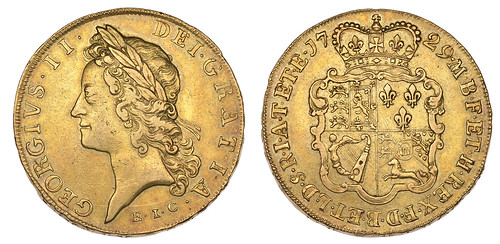
A rare Five Guineas coin minted from gold supplied to the Royal Mint by the East India Company in 1729 will be among the highlights of the auctions of Ancient, British and World Coins to be held by Dix Noonan Webb in London on 4–5 December 2014. The coin, which bears the head of George II, is expected to fetch £8,000 to £12,000. The source of the gold is shown by the letters ‘E.I.C.’ on the obverse of the coin underneath the king’s head.
Guineas took their place in British numismatic history in 1662 when the recently restored Charles II decreed that the Mint would abandon hand-hammered coinage in favour of money produced in screw presses that could produce symmetrical coins with milled edges to deter clipping. Gold for this came to England in ships of the Africa Company from Guinea in West Africa and the new coins soon became known as guineas.
The Africa Company’s badge of an elephant and howdah, more commonly called an elephant and castle, was depicted on the coins under the king’s bust. The practice of acknowledging the source of the gold continued into the 18th century with some guineas carrying the word LIMA to mark British successes in capturing Spanish treasure ships that had sailed from the city of Lima in Peru.
The East India Company, which had originally received its Royal Charter from Elizabeth I in 1600, also became gold suppliers to the Royal Mint. Quite where the ruthless entrepreneurs who expanded the Company to become effective rulers of the Indian sub-continent, sourced their gold is unclear although it may have come from Japan. What is known from Treasury records is that on 4 November 1729 the Company wrote to the Lords of the Treasury requesting the preparation of dies with the capital letters ‘E.I.C’ under the King’s head to distinguish the coins minted from its gold “as hath been granted to the Royal African, the South Sea Company and others.” The East India Company got what it wanted.
The coin to be auctioned at Dix Noonan Webb is rare. The letters ‘E.I.C.’ were only stamped on gold coins in 1729, two years after George II came to the throne, and five guineas are themselves rare because they represented an enormous amount of money.
For more information, see:
www.dnw.co.uk
MORE ON JAMES III
To find out more about James III and the four Stuart claimants to the throne of Great Britain, our readers might check out the American Numismatic Association DVD "Numismatics of Britain's Stuart Pretenders, 1688-1807," by David T. Alexander, produced by David Lisot (dlisot@cointelevisiohn.com) from a video of my Numismatic Theater presentation in 2013 at the Chicago ANA Convention. This is an in-depth survey of the pattern coins, medals and jetons issued by the exiled Stuarts after King James II was driven into exile in December 1688 after the birth of his son James Francis Edward aroused fears of a Catholic dynasty.
A cataract of supportive and viciously satirical medals greeted this birth, with the Whig enemies of the lawful King claiming that his infant son was a changeling introduced into the birth chamber in a warming pan. On the death of James II in 1701, he was succeeded by his son as James III of Great Britain and James VIII of Scotland, also called the Old Pretender. This second claimant continued efforts for a Stuart restoration until his death in 1766.
His son was "Bonnie Prince Charlie," Charles III (1766-1788) to the Jacobites. Charles led the great rising of 1745 that brought his largely Scottish army to within 100 miles of London. His defeat led to a wholesale English assault on Scottish culture and language, which reverberates to this day; recall the recent vote of Scottish independence... The last of the Stuart pretenders was Henry Benedict Maria, Cardinal Duke of York, who took the title Henry IX on Charles' death in 1788. Medals of these exiled Stuarts are a marvelous footnote to British history.
King William IV (IIII) had a little-known New York connection, living as Duke of Clarence and British naval officer on Hanover Square in lower Manhattan during the American Revolution. New York City remained under British occupation until 1783, and some of George Washington's officers came to him with a distinctly modern-sounding proposition. They proposed to kidnap William and offer to return him in exchange for Benedict Arnold, who had recently defected to the British. The straight-laced Washington refused this novel offer.
To read the earlier E-Sylum article, see:
NOTES FROM E-SYLUM READERS: OCTOBER 26,
2014 (www.coinbooks.org/esylum_v17n44a09.html)
IRISH GUN MONEY
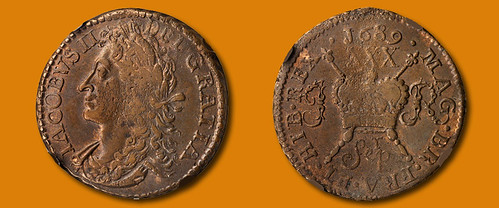
In this month’s iAuction featuring world coins, scheduled to close on Sunday, November 2, we are offering a relatively high quality example of an Irish “Gun Money” ½ Crown. Struck in Ireland during the Williamite War by the forces of James II, the appellation is derived from one of the sources of the brass (and other base metals) used to strike the coins, the cannons that were captured in battle (other sources included church bells).
The obverse features a left facing portrait of King James II, and the reverse has a crown superimposed on crossed scepters. The date, 1689, and denomination XXX (30 Pence) are above, with Sept. in script below. The idea behind the specified month was that in the event that James’ forces were victorious, the coins would be redeemable by month, for proper royal issue silver coinage. As fate would have it, James’ forces were defeated, and the Gun Money was never redeemed, but continued to circulate at discounted rates alongside regal coppers.
Because of the low quality metal used to strike them, most Gun Money coins are seen with porous planchets, corroded surfaces, and are usually low grade. This NGC-certified AU-53 is a nice exception, and is a very nice example for type purposes.
To read the complete article, see:
September 1689 ½ Crown Gun Money (www.stacksbowers.com/NewsMedia/Blogs/TabId/780/ArtMID/
2678/ArticleID/64825/September-1689-189-Crown-Gun-Money.aspx)
NORTHUMBERLAND TUDOR COIN HOARD GOES ON DISPLAY
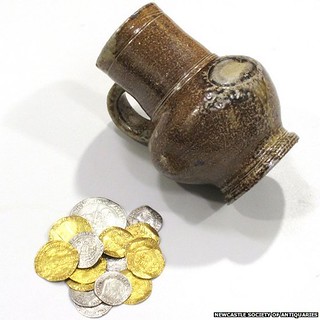 A hoard of Tudor coins unearthed in Northumberland
has gone on show after a fundraising campaign to buy them met its target.
A hoard of Tudor coins unearthed in Northumberland
has gone on show after a fundraising campaign to buy them met its target.
In 2003 a jug was found on Lindisfarne but as it was packed earth the 17 coins inside remained concealed until 2011.
After being declared as treasure, Newcastle's Society of Antiquaries campaigned to keep them in the region.
With £30,900 raised, they have gone on permanent display at Newcastle's Great North Museum: Hancock.
The 10 gold and seven silver coins span the reign of six English sovereigns and several European states with one - a gold scudo of Pope Clement VII, who refused to annul the marriage of Henry VIII to Catherine of Aragon in the 1520s - thought to be worth about £30,000 alone.
The oldest coin is a silver groat of King Henry VI, minted in the late 1420s or early 1430s, and the latest is a silver sixpence from the reign of Queen Elizabeth I, minted in London in 1562.
They are on show alongside a number of silver coins found at the same site in the 1960s.
To read the complete article, see:
Rare Tudor coins in Great North Museum:
Hancock display (www.bbc.com/news/uk-england-tyne-29836302)

HOW TO MAKE YOUR OWN COINS
So you want to make your own coins?
It’s not as hard as you may think
Anyone who pays attention to the modern new issues market quickly becomes aware of the outpouring of commemoratives, often from far-flung tropical island nations or war-torn African countries, but also from national mints like the Royal Canadian Mint and the Mint of Poland.
Private issuers abound, with European and Asian and even American companies directing programs intended to capture segments of the market.
Maybe you want to cash in on that craze by issuing your own coins, with a theme of your choosing? But invading a country is too dangerous, and buying a sovereign island outright is too expensive.
So, you could always partner with a mint that already has a relationship with an issuing authority like Palau, the Cook Islands, or Somalia. Let’s assume that you will coordinate the program with the Mint of Poland, which issues coins for the National Bank of Poland as well as several other partners.
You need a license to drive, but why do you need a license to issue coins?
Well, in this case, the sovereign privilege of striking coins comes at a price. Each nation is responsible for its money supply, and commemorative coins, though unlikely ever to be cashed, are in accounting-speak potential liabilities to the bottom line.
Whether it is Niue or Armenia or Belarus or any other country you want to officially issue the coins, there is a cost that must be paid. Issuers are always quiet about this relationship, but recent news reports about the New Zealand Mint suggest that the company alone pays about half-a-million dollars U.S. every year for the dozens of coin programs it issues under that island’s name.
Suddenly this proposition seems a little pricey, huh?
To read the complete article, see:
SO YOU WANT
TO MAKE YOUR OWN COINS?
(www.coinworld.com/voices/jeff-starck/2014/10/_so_you_want_to_make.html)
To read the earlier E-Sylum article, see:
MICRONATION STATECRAFT FOR DUMMIES
(www.coinbooks.org/esylum_v17n43a21.html)
CAN AN AUCTIONEER BE SUED OVER A MISATTRIBUTION?
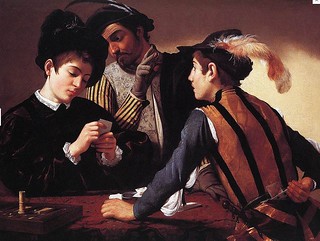 A bitter dispute over a painting bought for £140 five
decades ago reaches the High Court today – with some of the world’s most prominent Caravaggio
experts lining up to take sides.
A bitter dispute over a painting bought for £140 five
decades ago reaches the High Court today – with some of the world’s most prominent Caravaggio
experts lining up to take sides.
Sotheby’s is being sued over claims that it misattributed a work – The Cardsharps – to a follower of Caravaggio rather than the Italian painter himself, costing the seller millions of pounds.
The painting was sold through the auction house in 2006 by a descendant of a Royal Navy surgeon who first acquired it in 1962. Sir Denis Mahon, a British collector, secured the painting for a hammer price of £42,000 – but then declared the work to be an original and valued it at £10m.
In papers filed at the court, the seller, Lancelot Thwaytes, claims that the auction house did not consult enough experts or sufficiently test the painting before the sale.
The painting is nearly identical to another under the same name on display at Kimbell Art Museum in Texas. The paintings show a young, privileged man falling victim to a pair of cheats during a game of cards.
To read the complete article, see:
Caravaggio in court: Sotheby's sued over misattribution of painting later valued at £10m
(www.independent.co.uk/arts-entertainment/art/news/caravaggio-in-court-sothebys-sued-over-misattribution-of-painting-later-valued-at-10m-so-the-man-who-sold-it-for-42000-is-not-happy-9819798.html)
THE PAINTED COINS OF ARTIST ANDRE LEVY
Talk about cultural currency! The Sao Paulo–born, Frankfurt-based artist and designer Andre Levy has earned himself a huge online following and an exhibition at Stew Gallery in Norwich, England with his project Tales You Lose, for which he turns the portraits of monarchs and political heroes adorning coins into images of pop culture icons including transforming the image of Franco on a Spanish coin into Divine, turning an Olympian on a Greek coin into the Flash, and remaking a Chinese coin into miniature version of René Magritte’s “The Son of Man.”
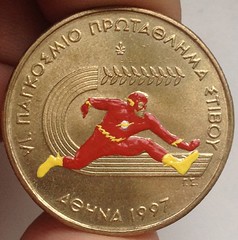
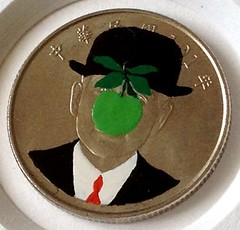
The Flash and Magritte
“I’m a graphic designer and split my time between an advertising job and my personal projects, which include street art and illustration. The most notorious of those projects, so far, is Tales You Lose, which became popular on Instagram and Tumblr,” Levy told Hyperallergic over email. “I never collected coins. What initially made me accumulate a few was the fact that I keep forgetting them in my pockets. I learned, though, that outside its territory of origin the coin leaves behind its illusional value as currency to carry a value defined by its carrier. I saw those coins as massively reproduced sculptures, and felt they could be turned into templates for something richer. Painting the coins was a way to give those metal pieces some room for interpretation. The pop characters where a way to bring in narratives as strong as the original ones and enable the new stories when people relate both characters.”
For some, the defacing of currency might constitute a political statement, but Levy doesn’t see the project in those terms. “I know many of the original faces I cover with paint, but my intention is rarely to induce an interpretation or forcing a connection by using my own political views,” he says. “Some pieces ‘make sense’ if the viewer have a previous opinion about both the person on the coin and the added character. But my statement is in the collection itself. It’s about showing the value of individual personality over massified behavior and redefining people’s emotional connection to money.”

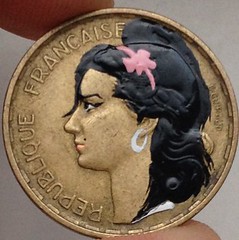
Leonardo and Amy Winehouse
So, which currencies are most amenable to Levy’s brand of pop cultural augmentation?
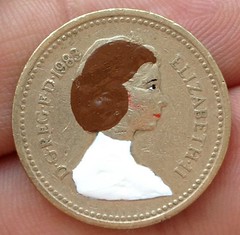 “In general I love British coins because Queen
Elizabeth has a great female silhouette, and the fact that she turns older every new edition makes
her face the most versatile of all,” the artist says. “The ‘Vitruvian Man’ on the Italian euro
allows me to to full body figures. Some people are more sensitive than others regarding seeing
their rulers or heroes dressed as someone else, but most reactions are positive, even when I paint
villains, proving that people can deal with their money in a more imaginative way than simply
spending or hiding it.”
“In general I love British coins because Queen
Elizabeth has a great female silhouette, and the fact that she turns older every new edition makes
her face the most versatile of all,” the artist says. “The ‘Vitruvian Man’ on the Italian euro
allows me to to full body figures. Some people are more sensitive than others regarding seeing
their rulers or heroes dressed as someone else, but most reactions are positive, even when I paint
villains, proving that people can deal with their money in a more imaginative way than simply
spending or hiding it.”
To read the complete article, see:
Savvy
Miniaturist Mints Pop Culture Portraits on Coins
(hyperallergic.com/159598/master-miniaturist-mints-pop-culture-portraits-on-coins/)
For more images on Tumblr, see:
http://talesyoulose.tumblr.com/
For more information about the artist, see: http://talesyoulose.tumblr.com/about
2015 COIN OF THE YEAR NOMINEES
Krause Publications, a leading producer of coin and paper money books, magazines, events and online products, has announced the 94 nominees for the 2015 Coin of the Year awards.
Each year, the awards honor the best in coin design from around the world. The awards will be presented during a ceremony Jan. 31, 2015, at the World Money Fair in Berlin, Germany.
The coins nominated for this year's awards were released in 2013, and represent the highest achievement in theme, design and marketing from mints and central banks from around the world.
A panel of judges who are authors, editors and numismatists, as well as members of the American Numismatic Association and Citizens Coinage Advisory Committee, met Oct. 3 in Iola, Wis., to choose the following nominees from hundreds received from around the world.
These nominees will now be reviewed by an international panel of 80 judges comprised of mint and museum officials, journalists and individual experts. They will choose a winner in each of 10 individual categories. A second round of balloting will select the Coin of the Year from among the category winners.
This year, World Coin News is also giving the public a chance to see if their selections match the judges' choices. Though the public input will have no impact on the actual winners, the public will have the satisfaction of knowing whether they agree or disagree with the judges' results. The public can vote online here: http://svy.mk/1nMTHPp
Most Artistic Coin
Fiji — Malachite Room ~ Hermitage: 10 Dollars, Silver [KM# 366]
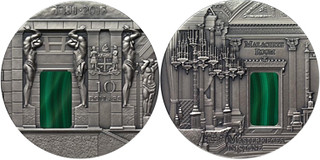
Australia — Land Down Under ~ Surfing: 1 Dollar, Silver [KM# 2051]
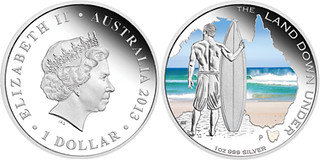
New Zealand — Maori Art: 1 Dollar, Silver [KM# 373]
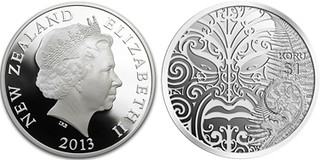
Gold Coins
Italy — Botticelli's Personification of Spring: 20 Euro, Gold [KM# 365]
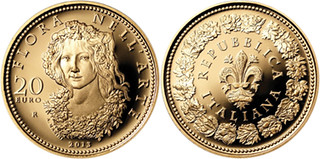
Austria — Klimt & His Women ~ The Expectation: 50 Euro, Gold [KM# 3218]
![Austria — Klimt His Women ~ The Expectation 50 Euro, Gold [KM# 3218]](https://farm4.staticflickr.com/3956/15660712926_620d7248e7_n.jpg)
Great Britain — Benjamin Britten ~ 100th Anniversary of Birth: 50 Pence, Gold [KM# 1253b]
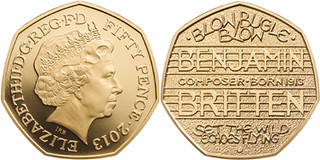
INSPIRATIONAL Coins
France — Dove & Peace in Various Languages: 250 Euro, Gold [KM# 1764]
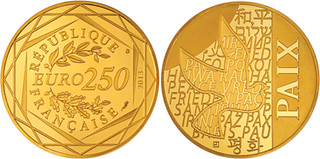
Australia — ANZAC Day ~ Engineers: 1 Dollar, Aluminum-Bronze [KM# 2045]
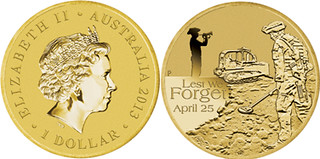
Canada — Grandfather & Grandson Fishing: 3 Dollars, Silver [KM# 1485]
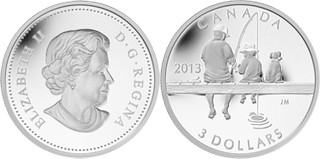
FEATURED WEB SITE: MEDAL GALLERY
This week's Featured Web Site is the Medal Gallery, a new site hosted by Hof Numismatica of The Netherlands. It has images of medals in multiple categories including Art Medals, Exposition Medals, Art Deco and Art Nouveau.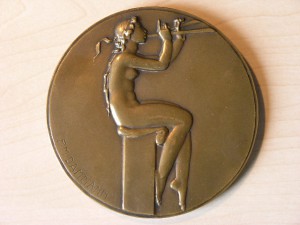
www.medals.eu

